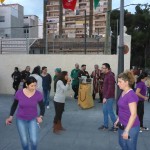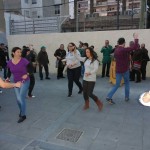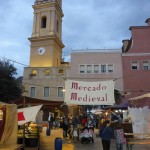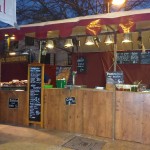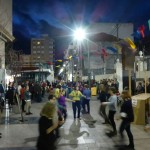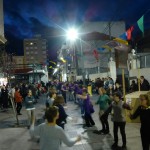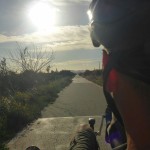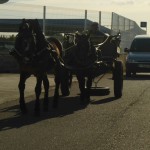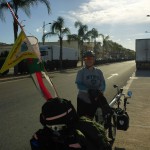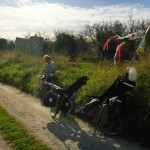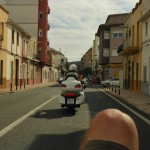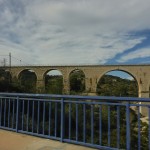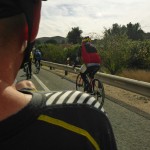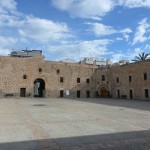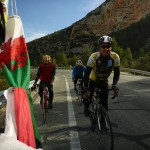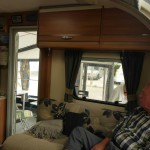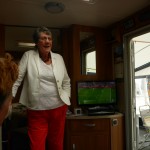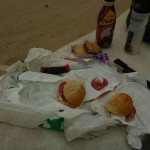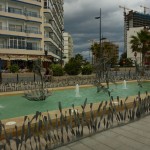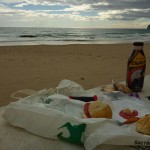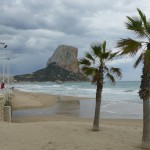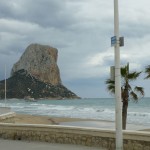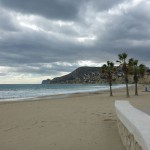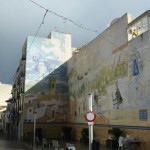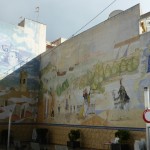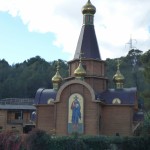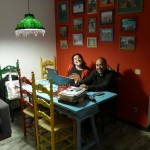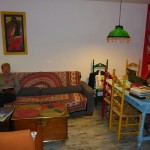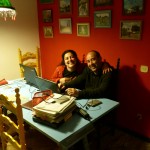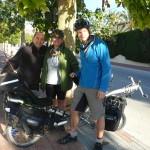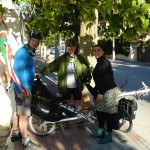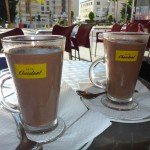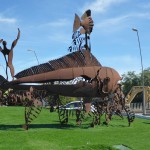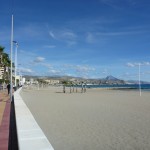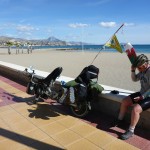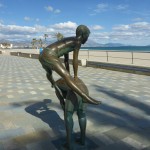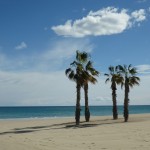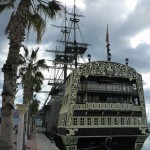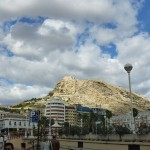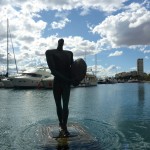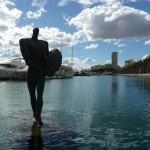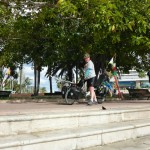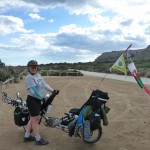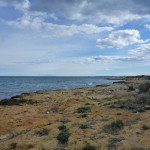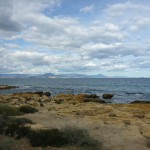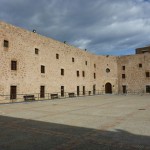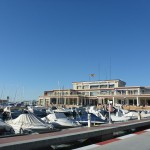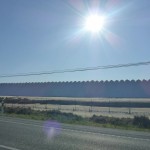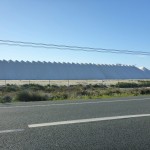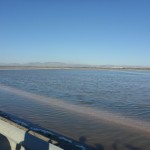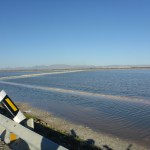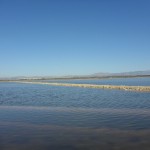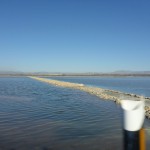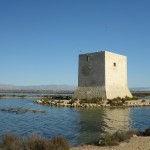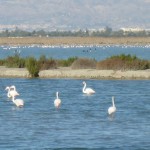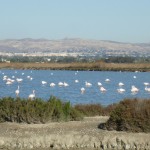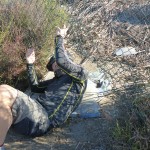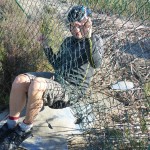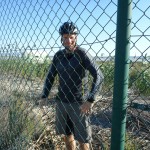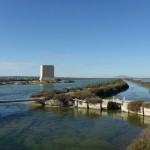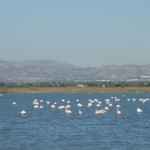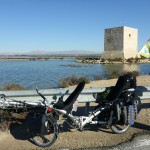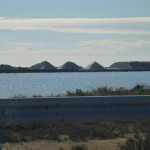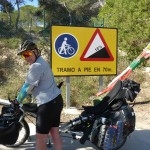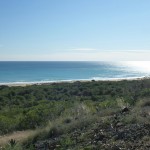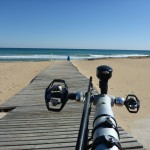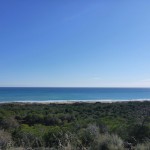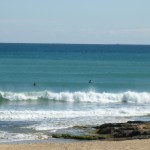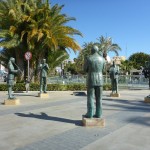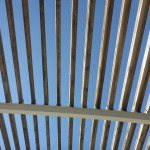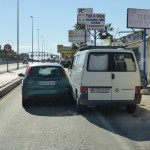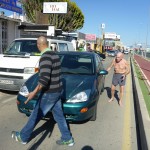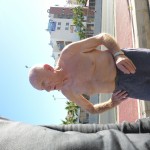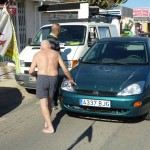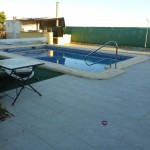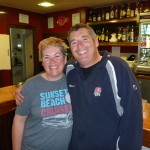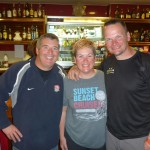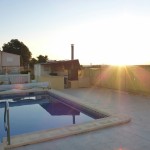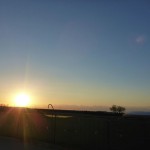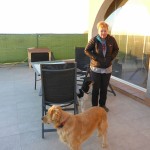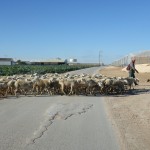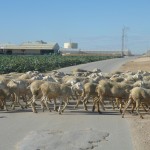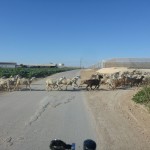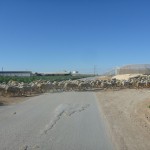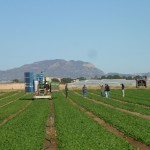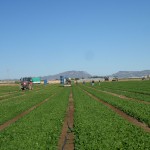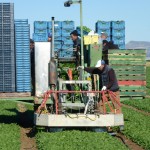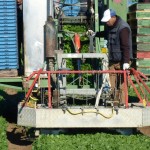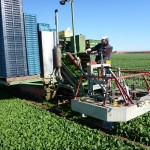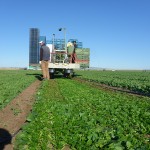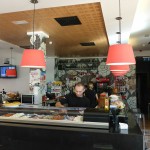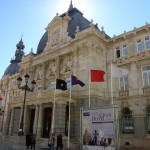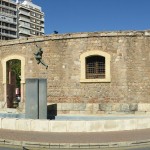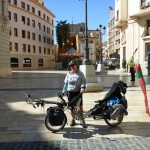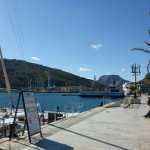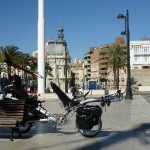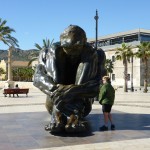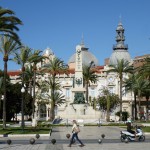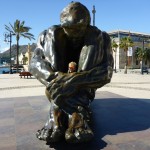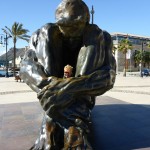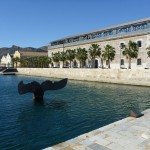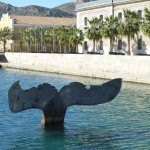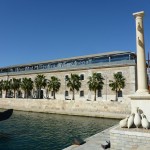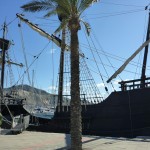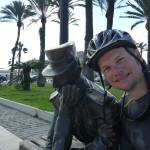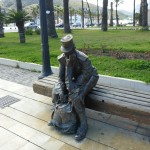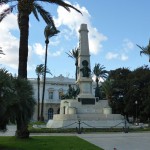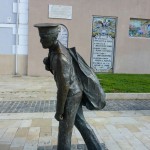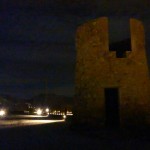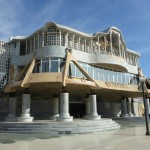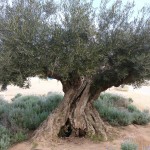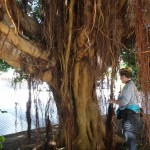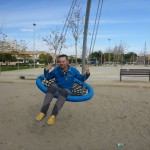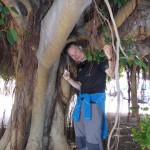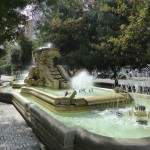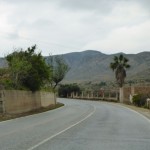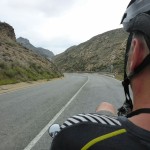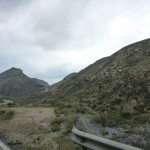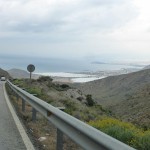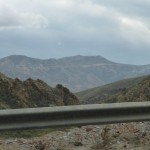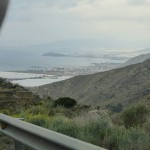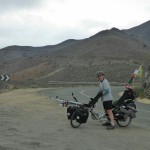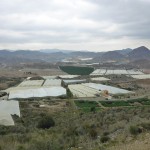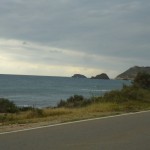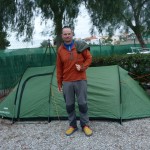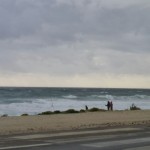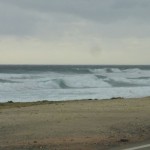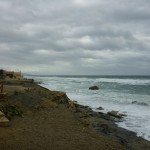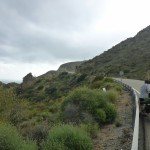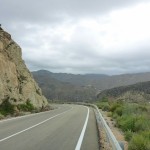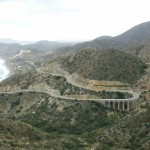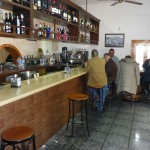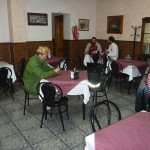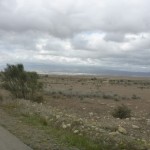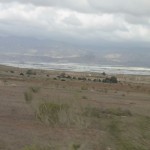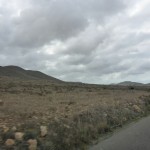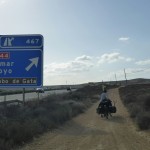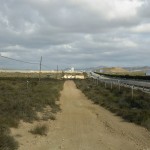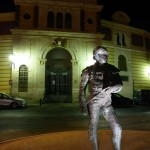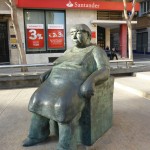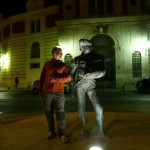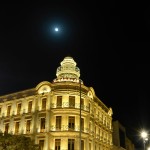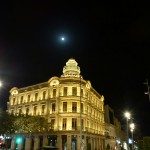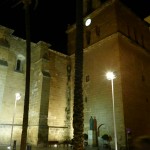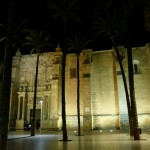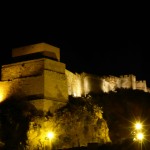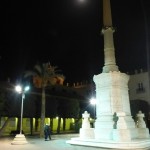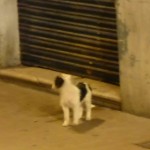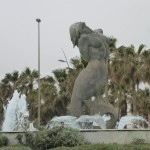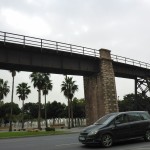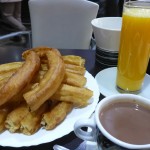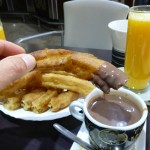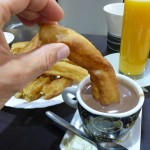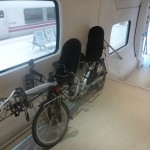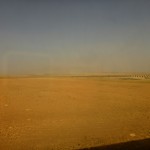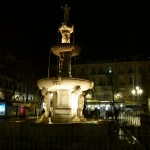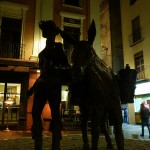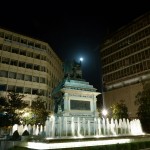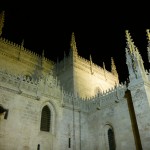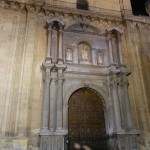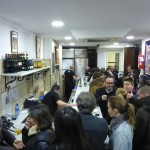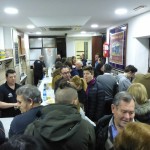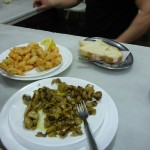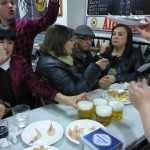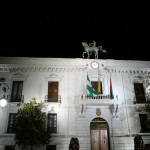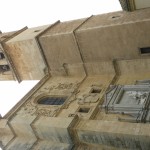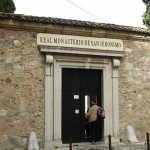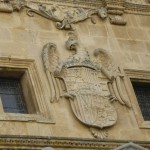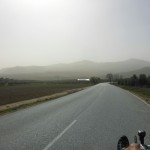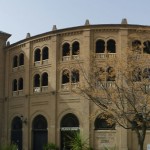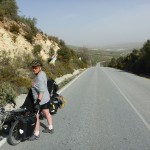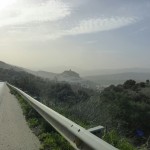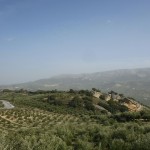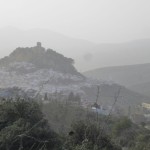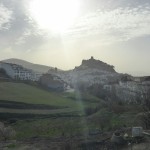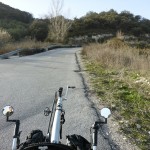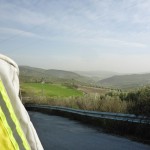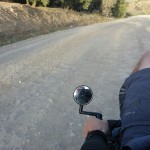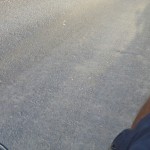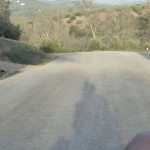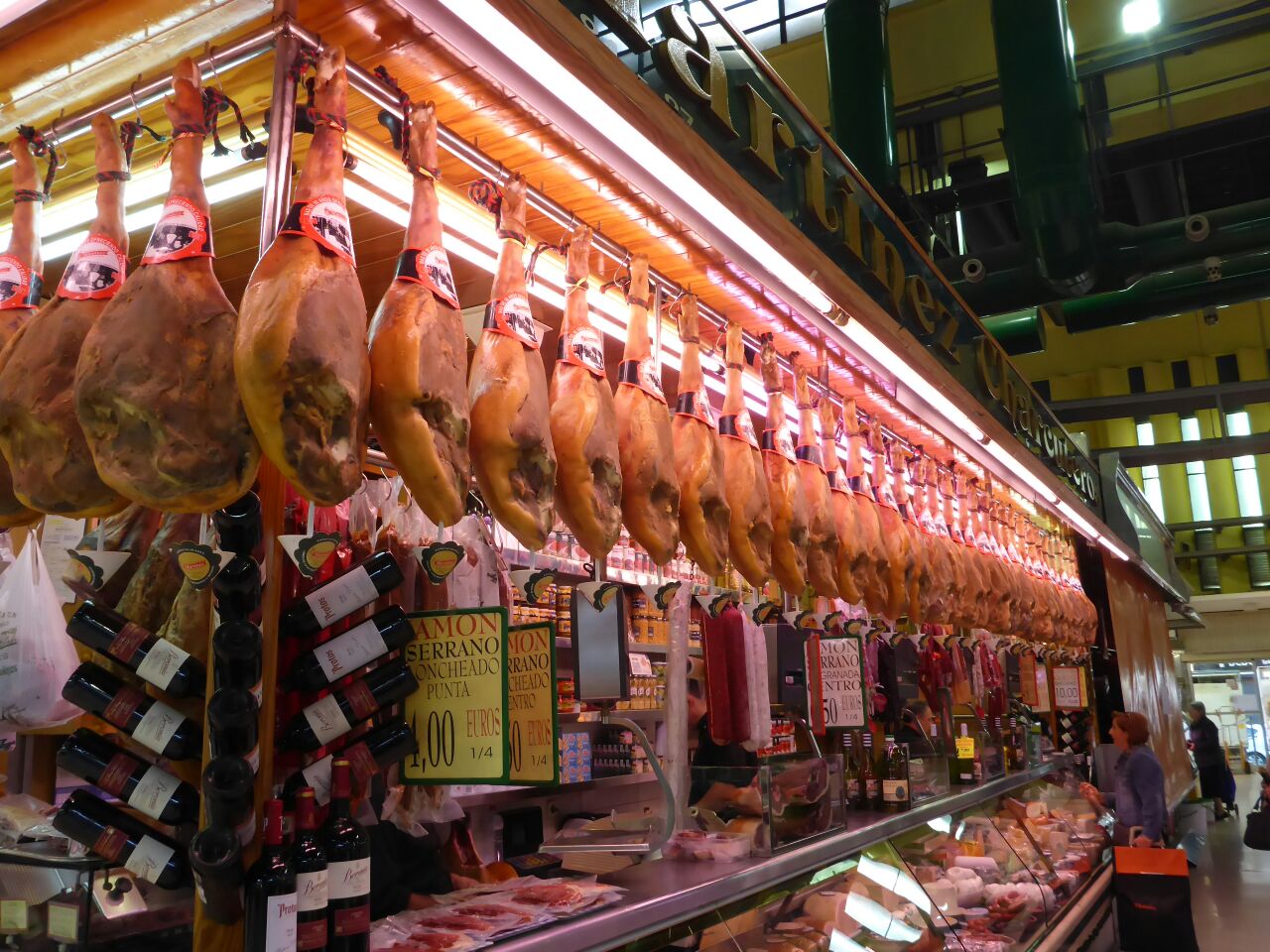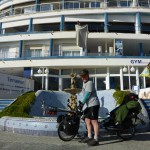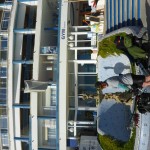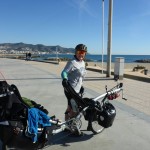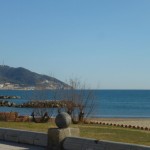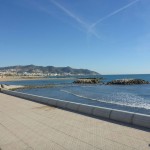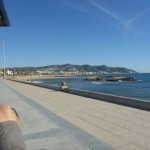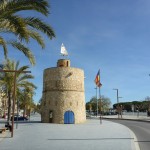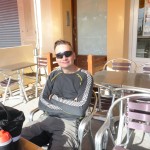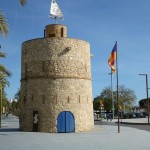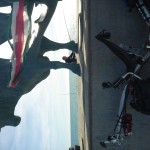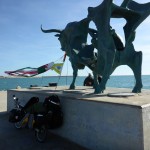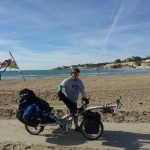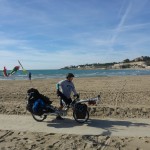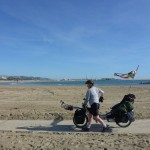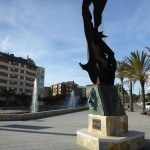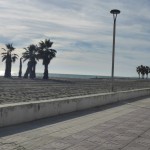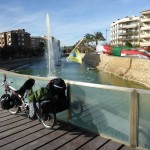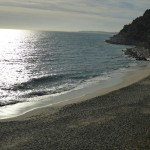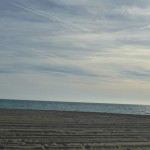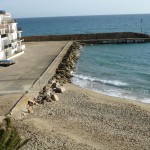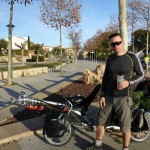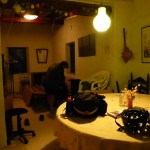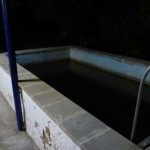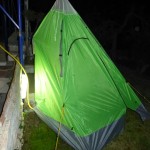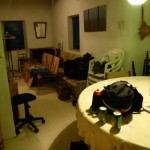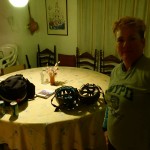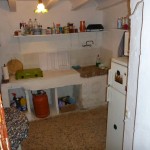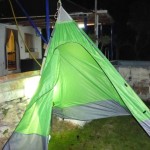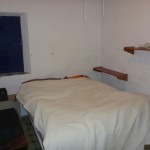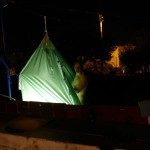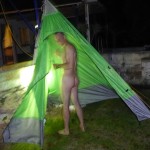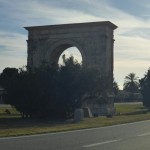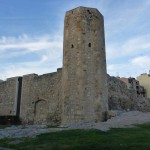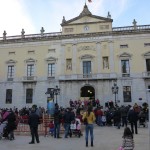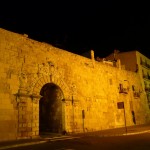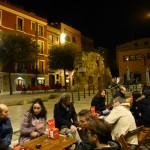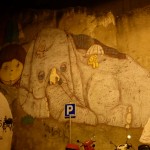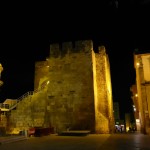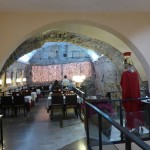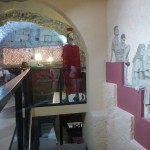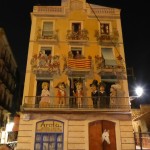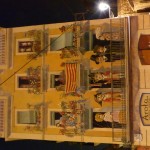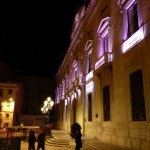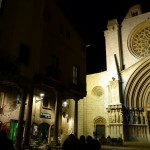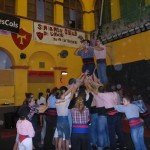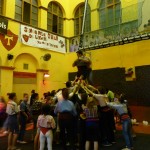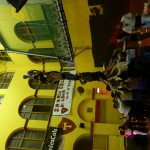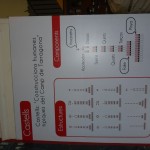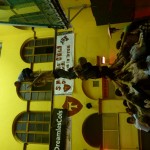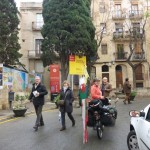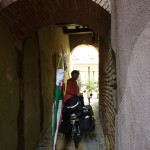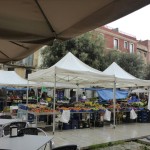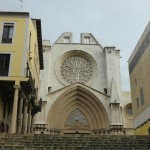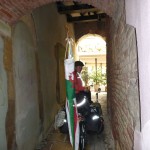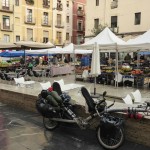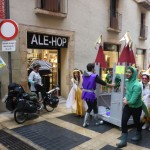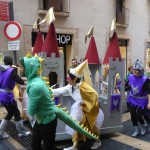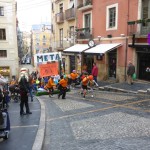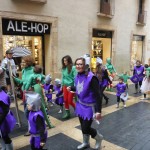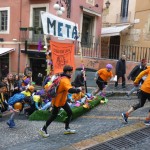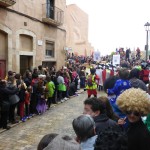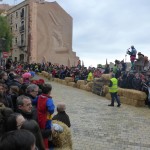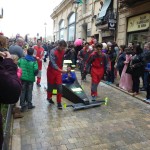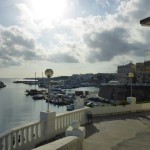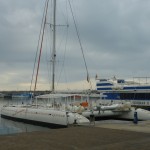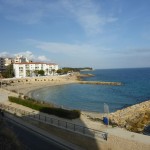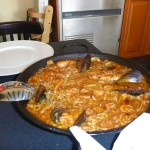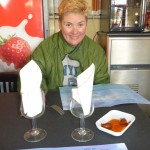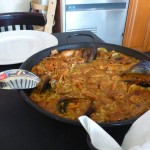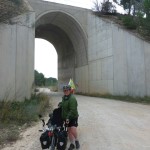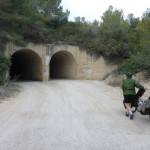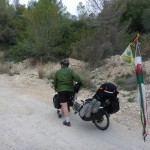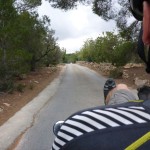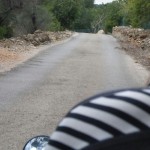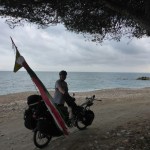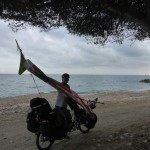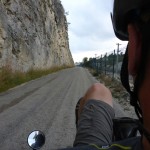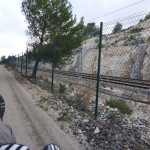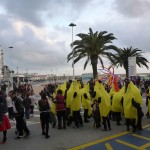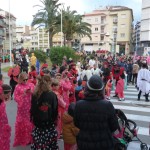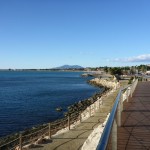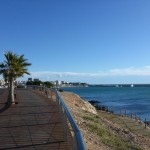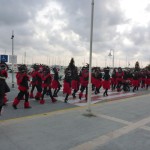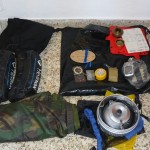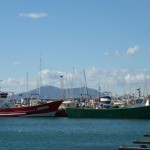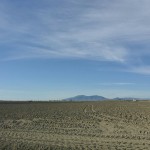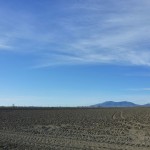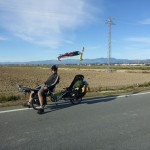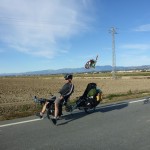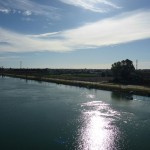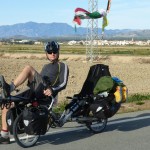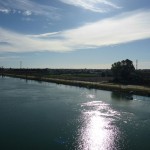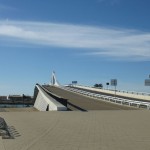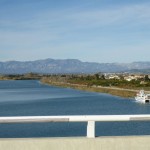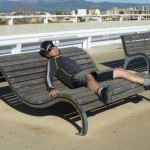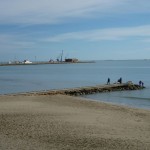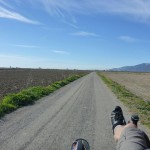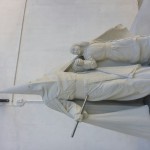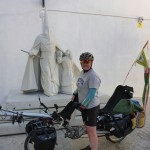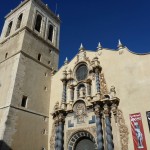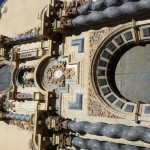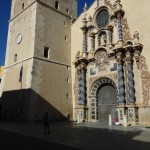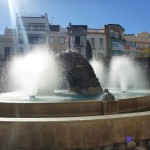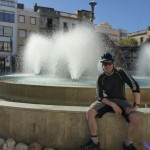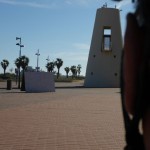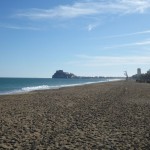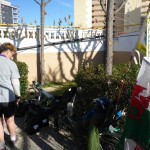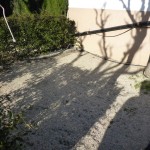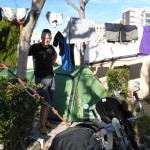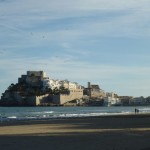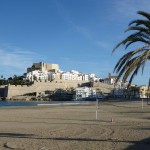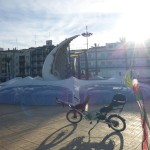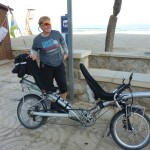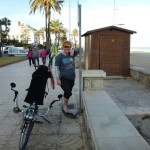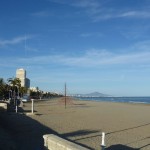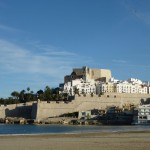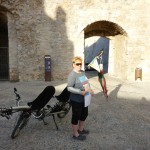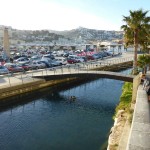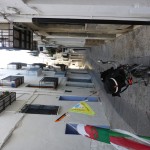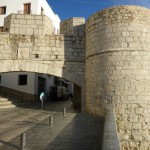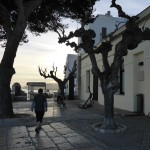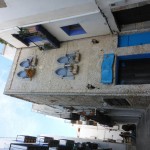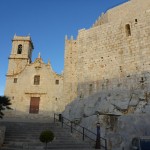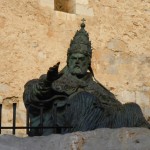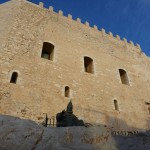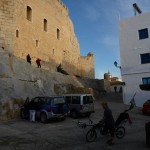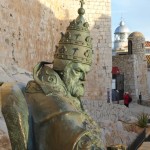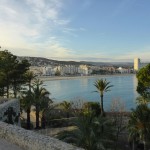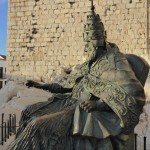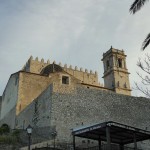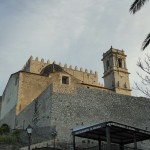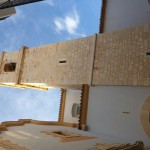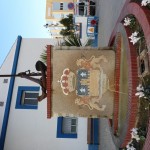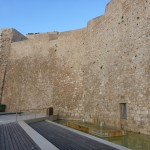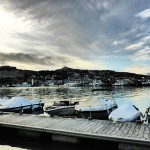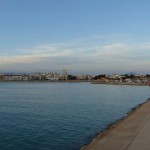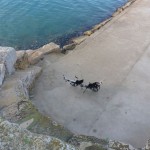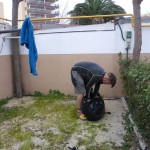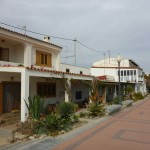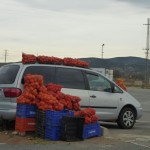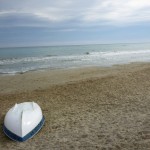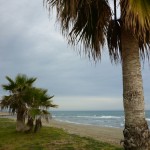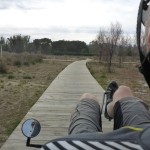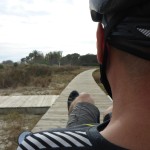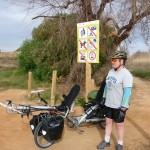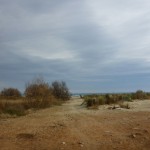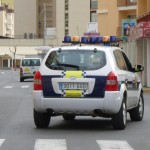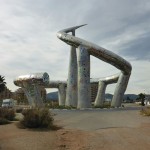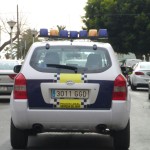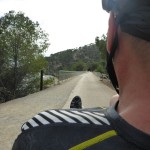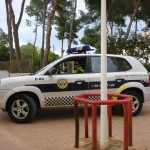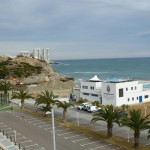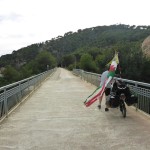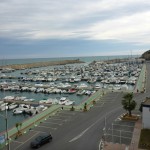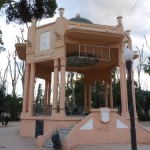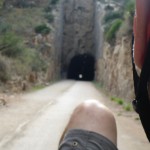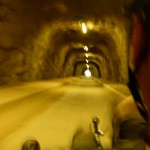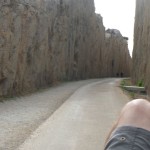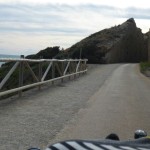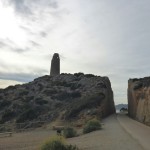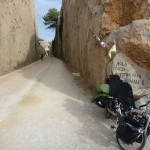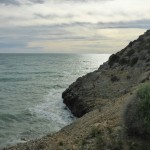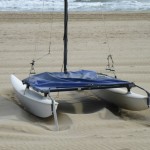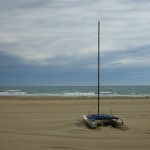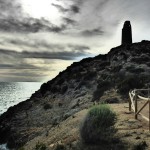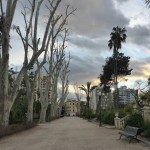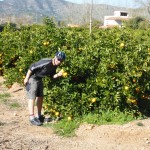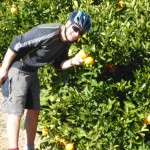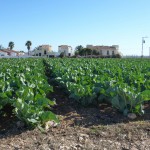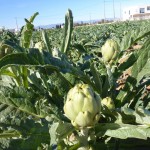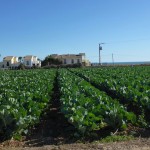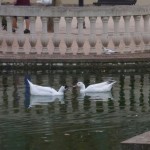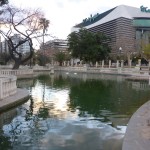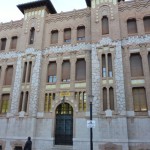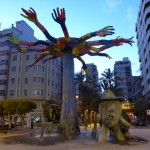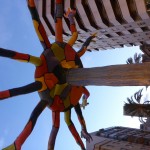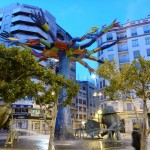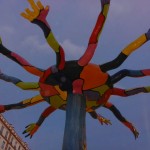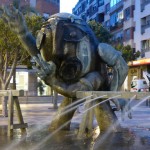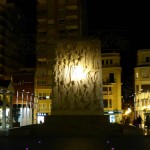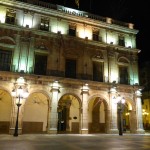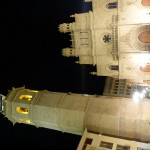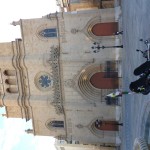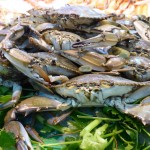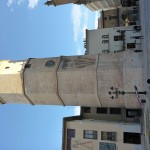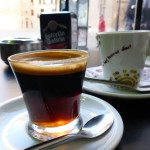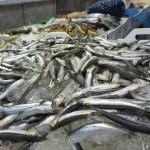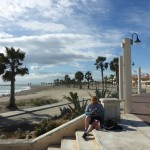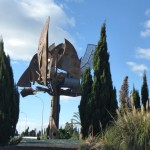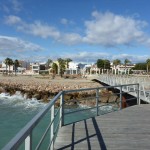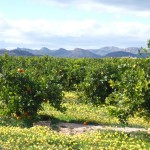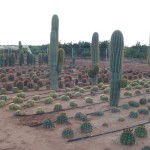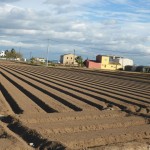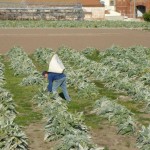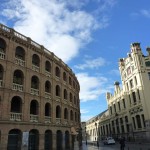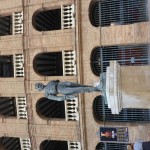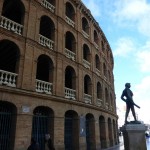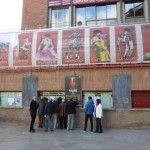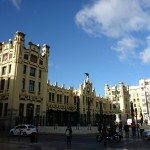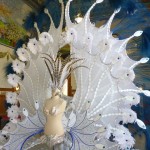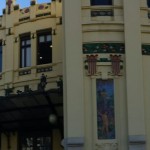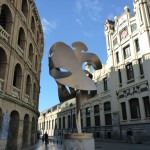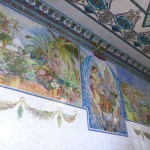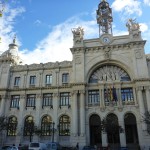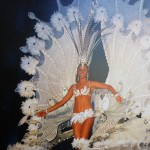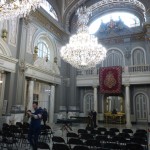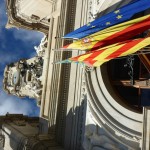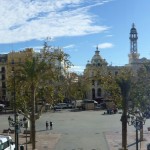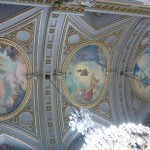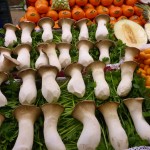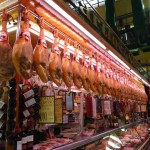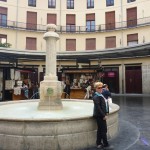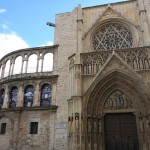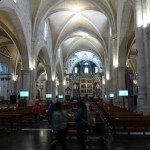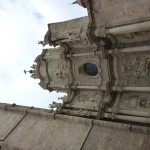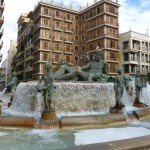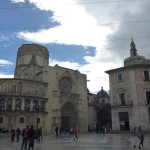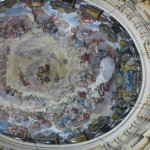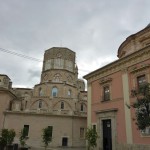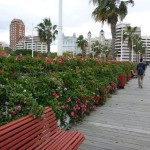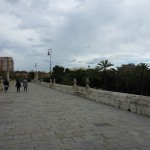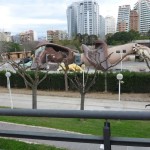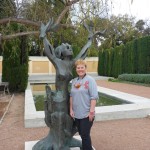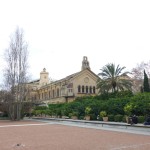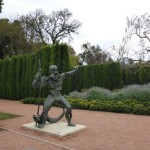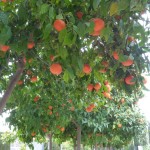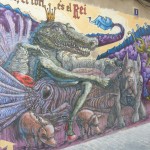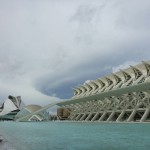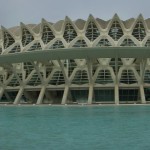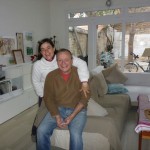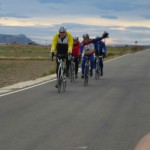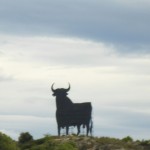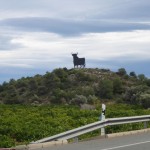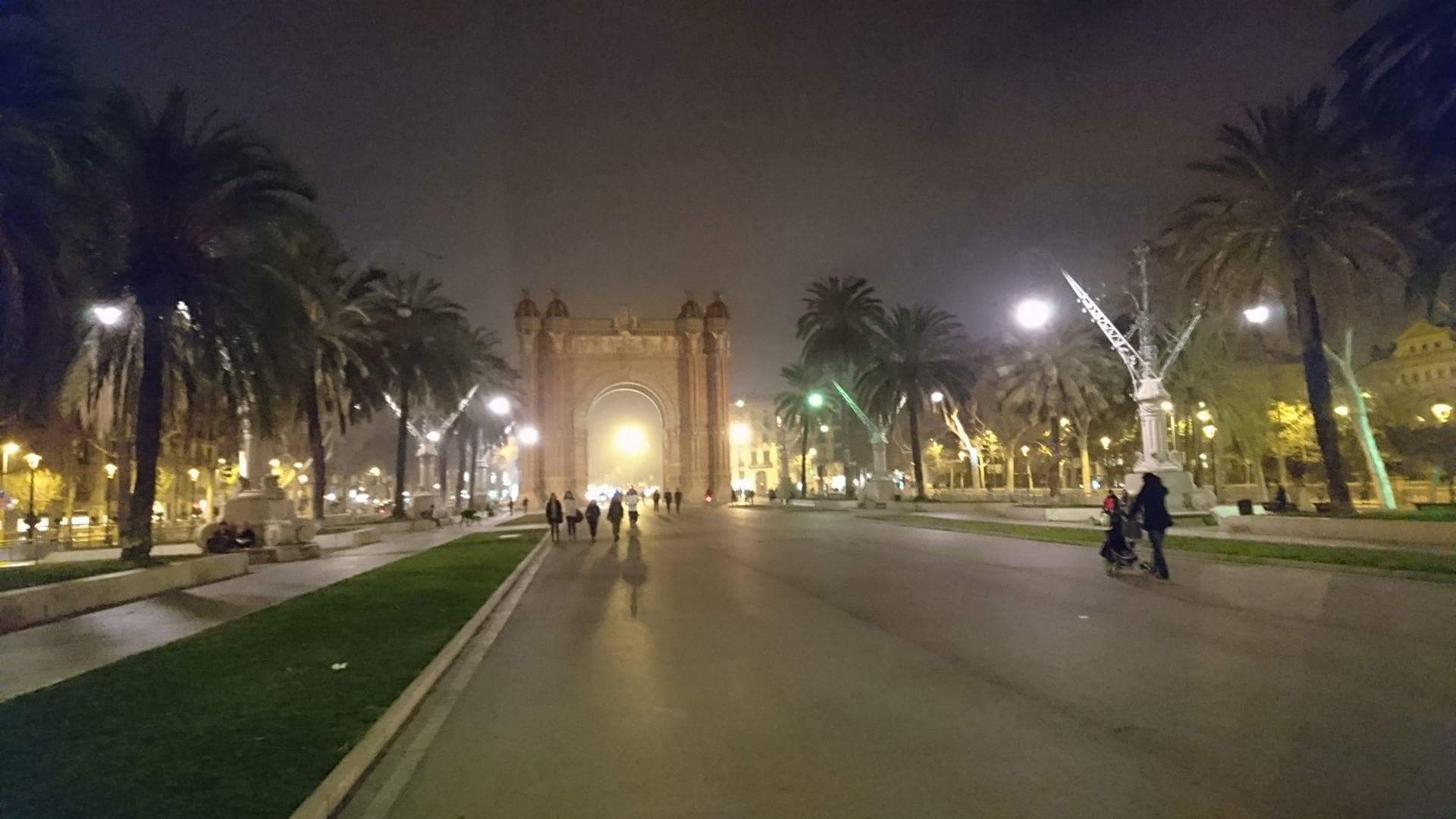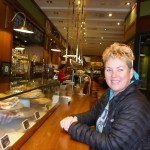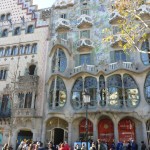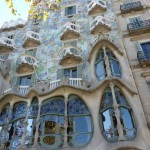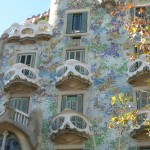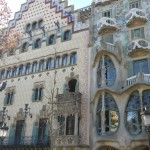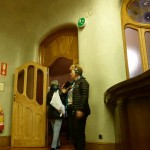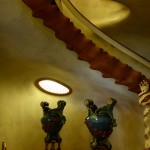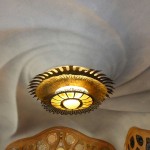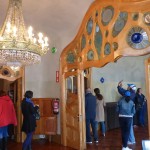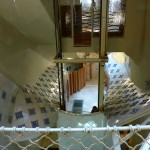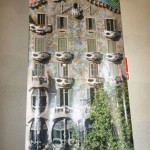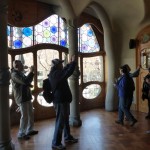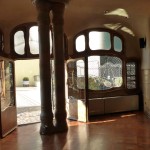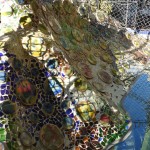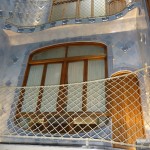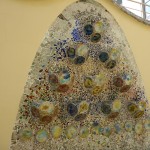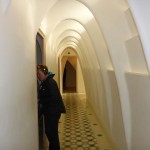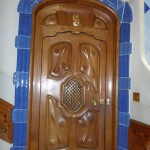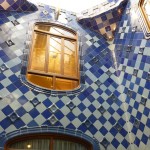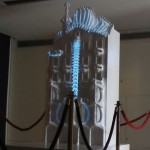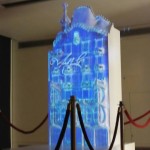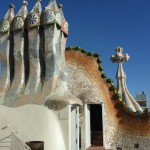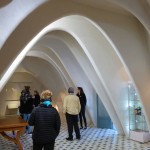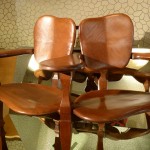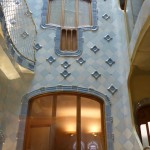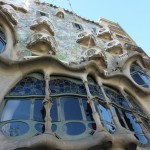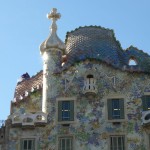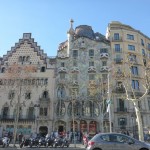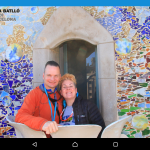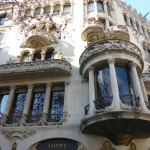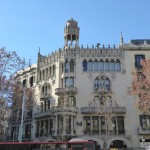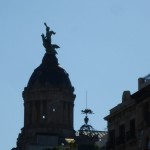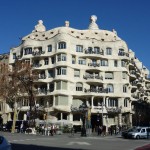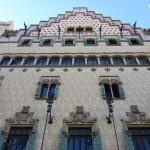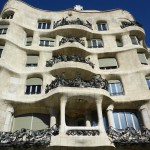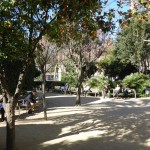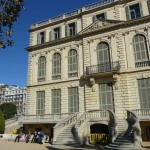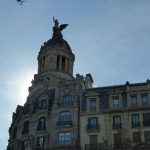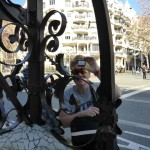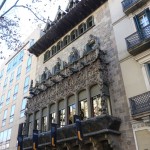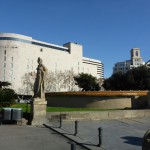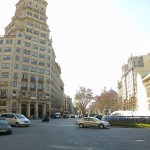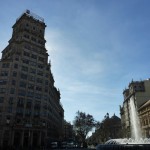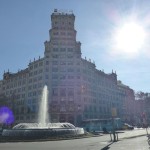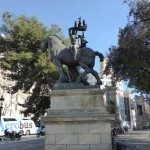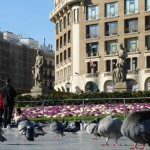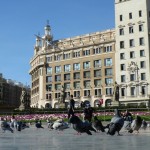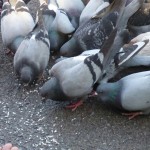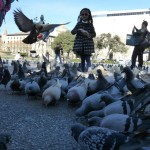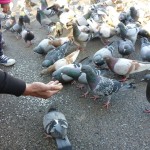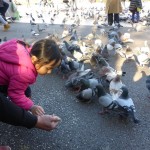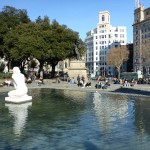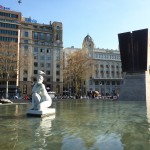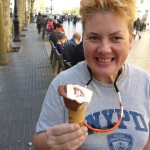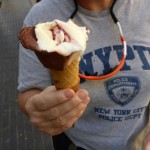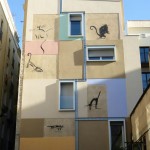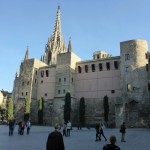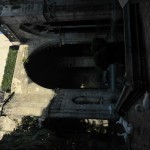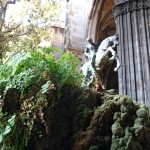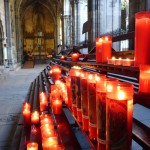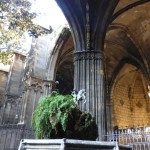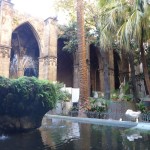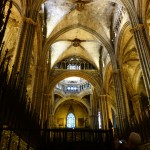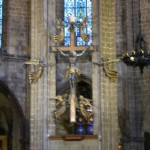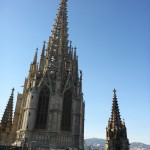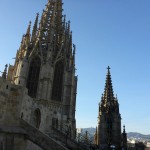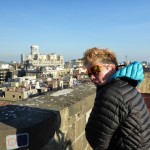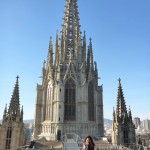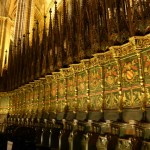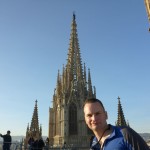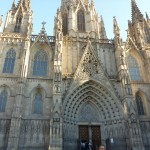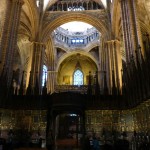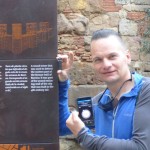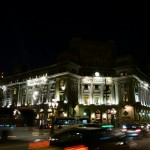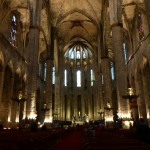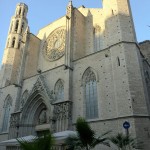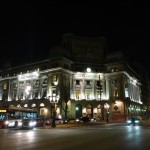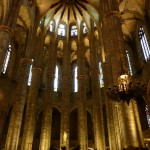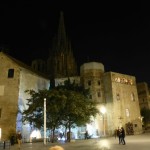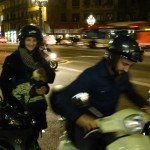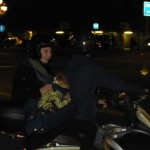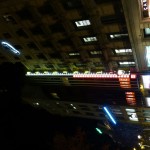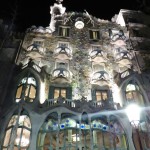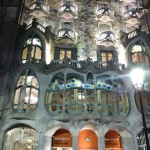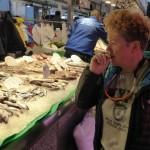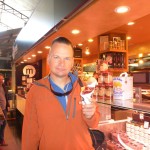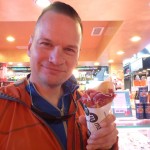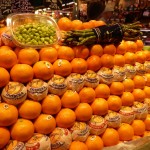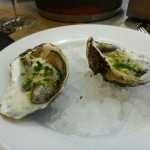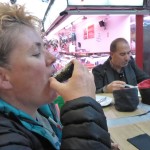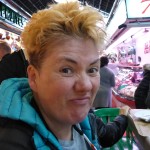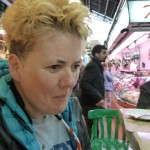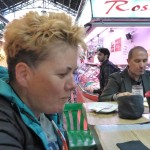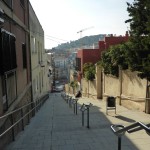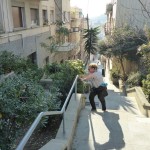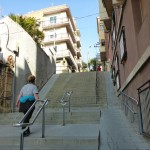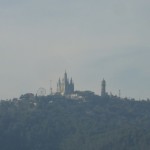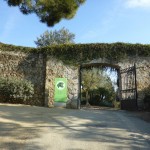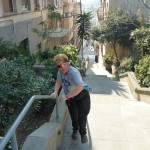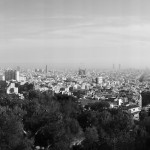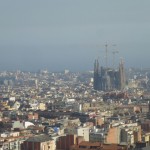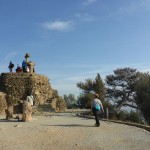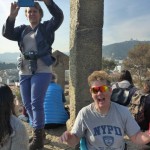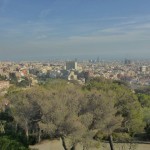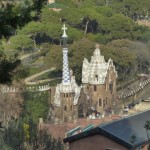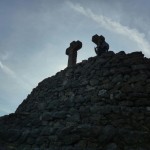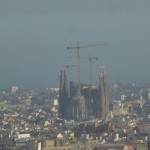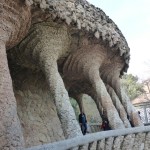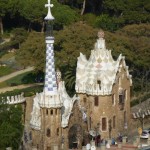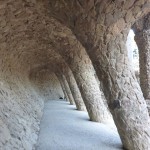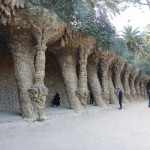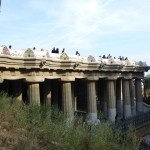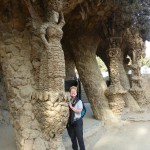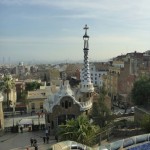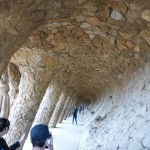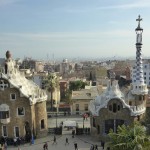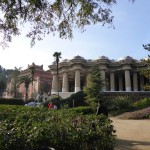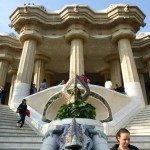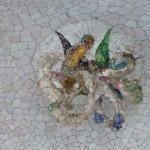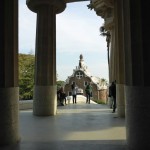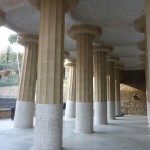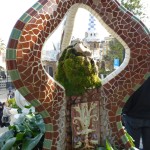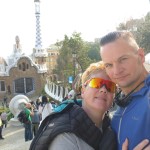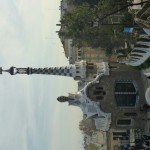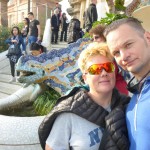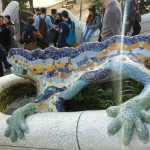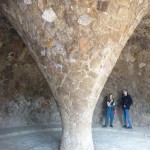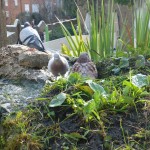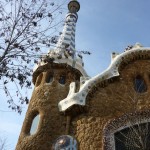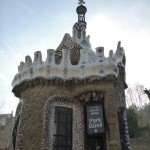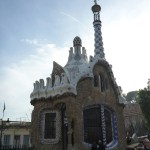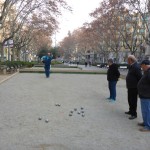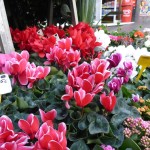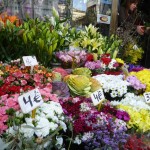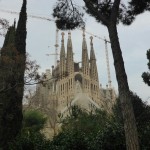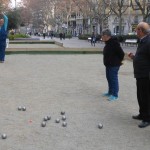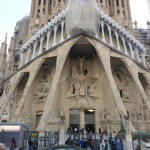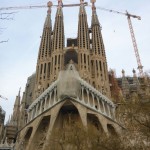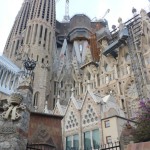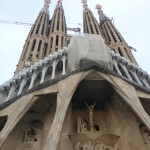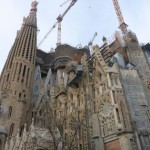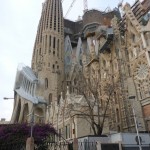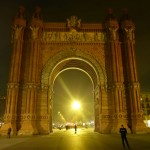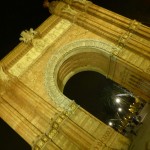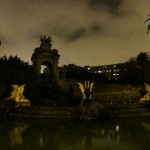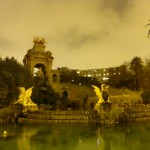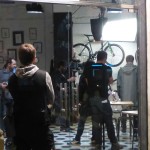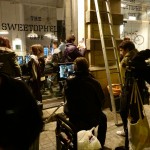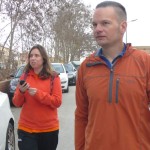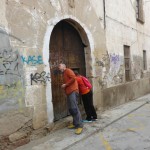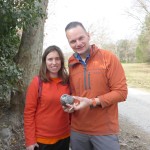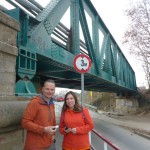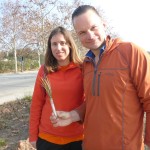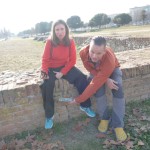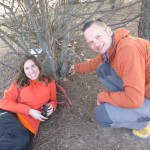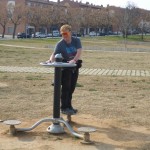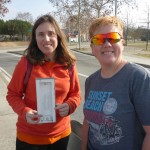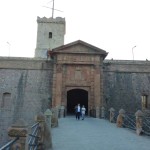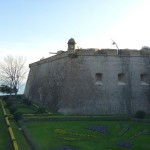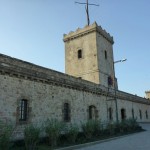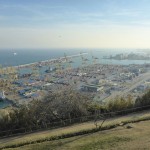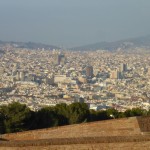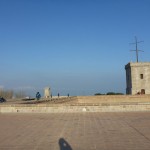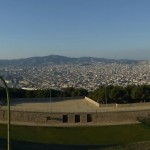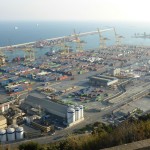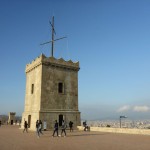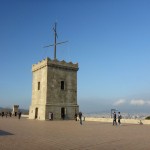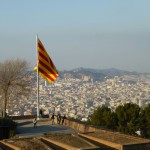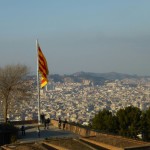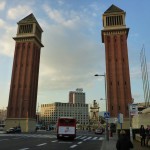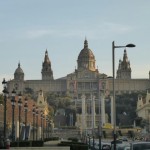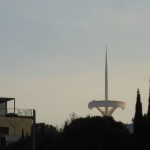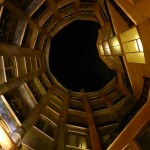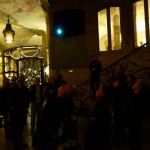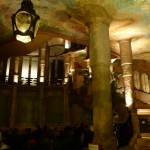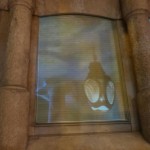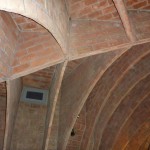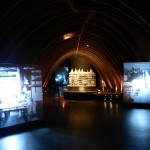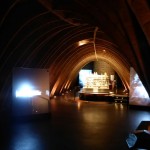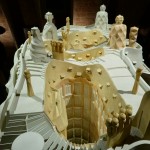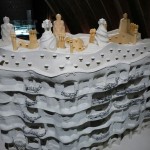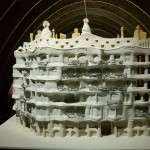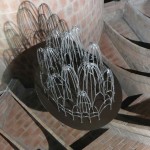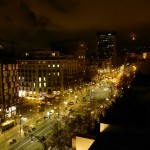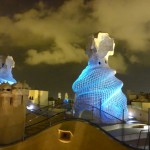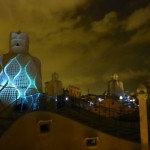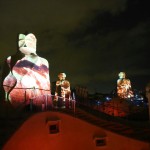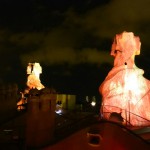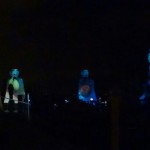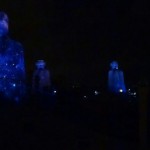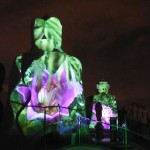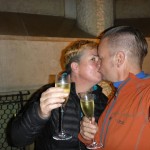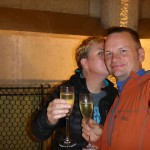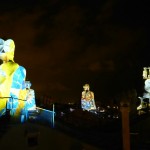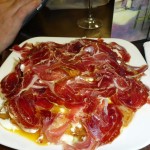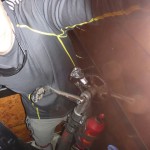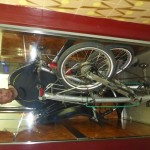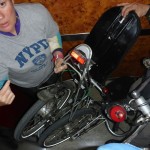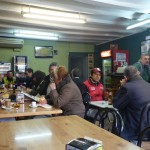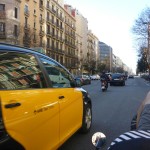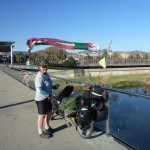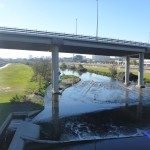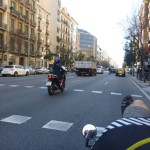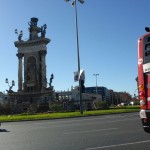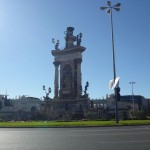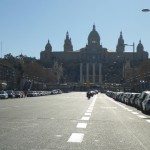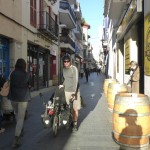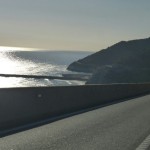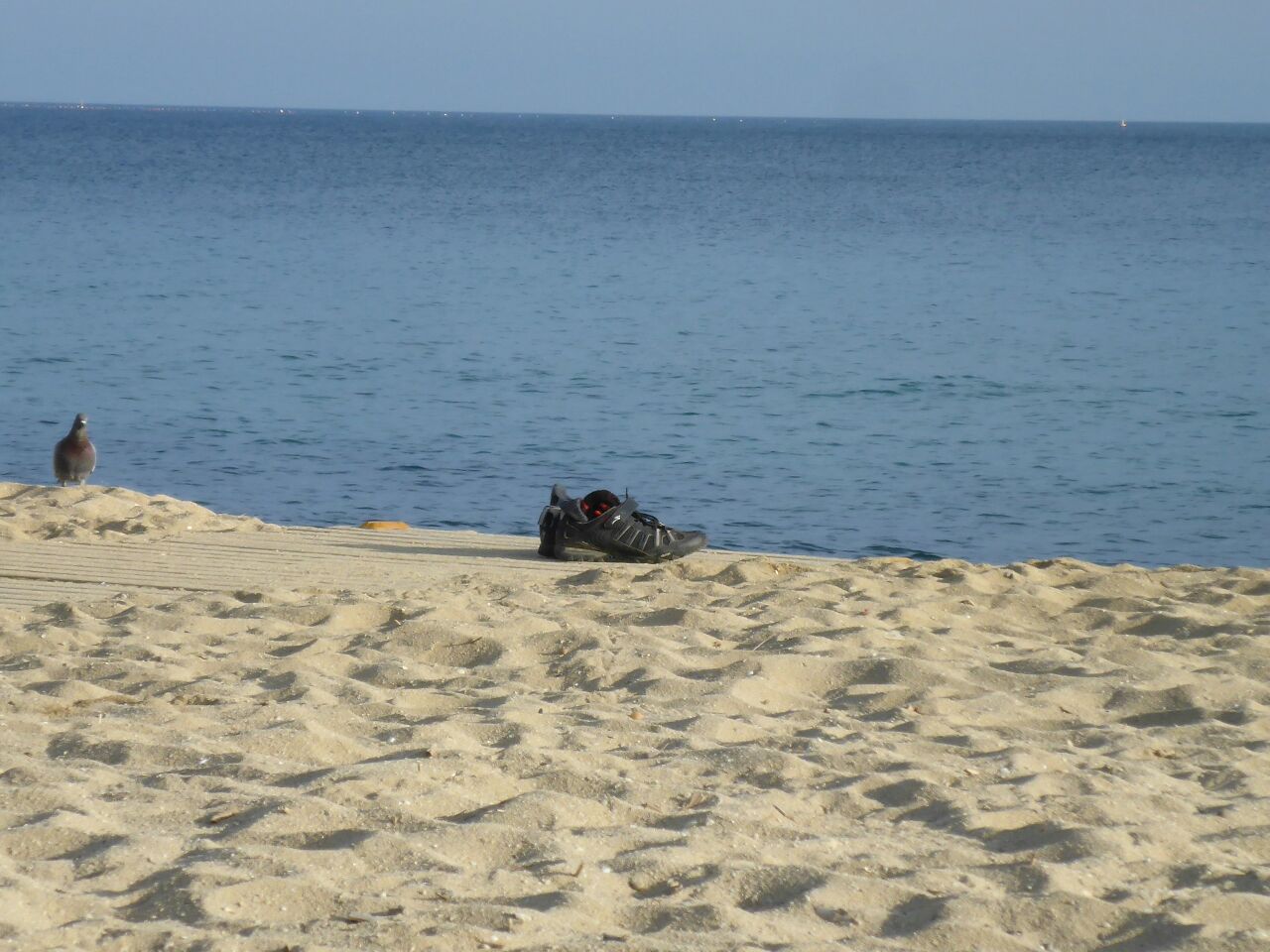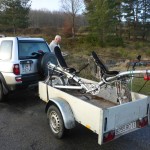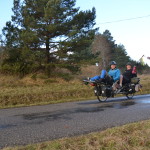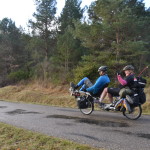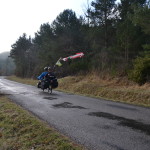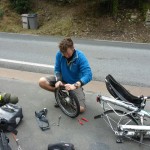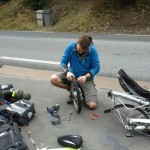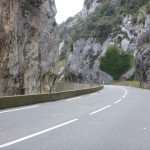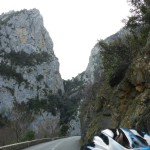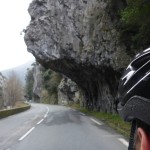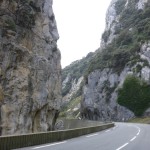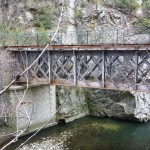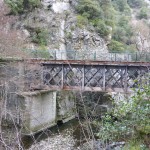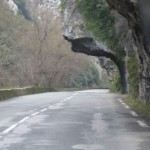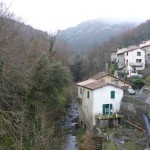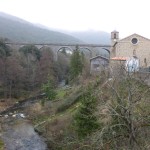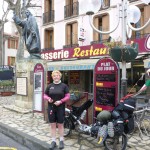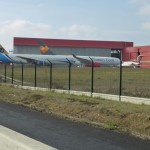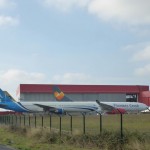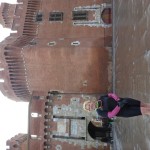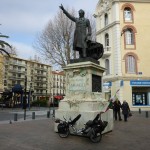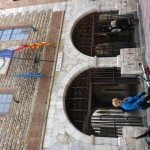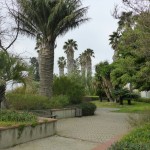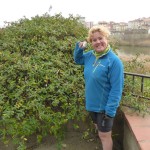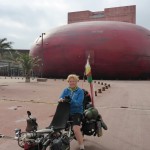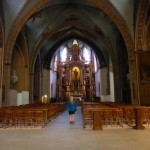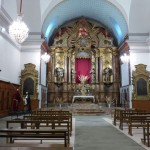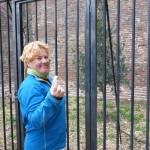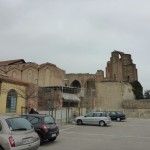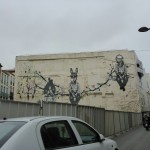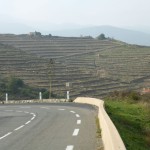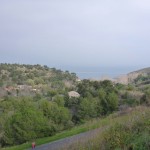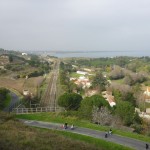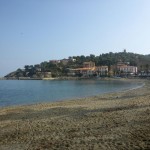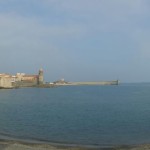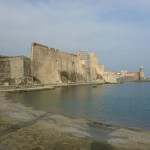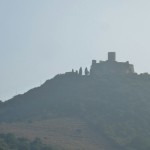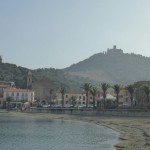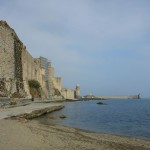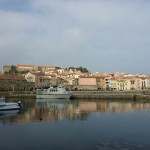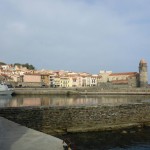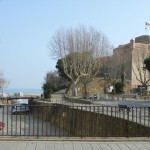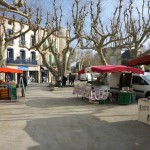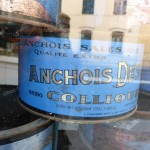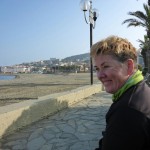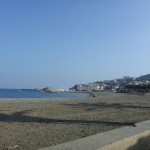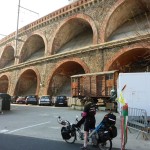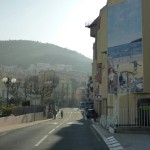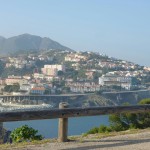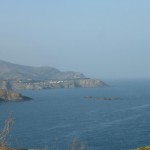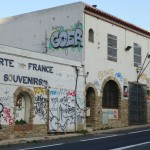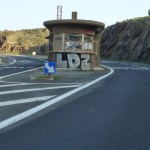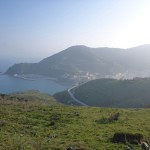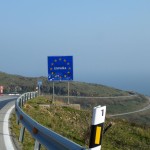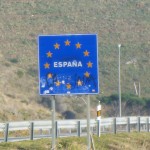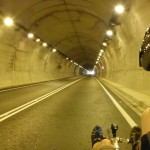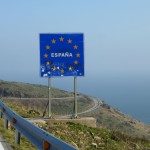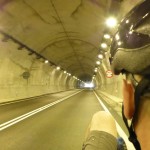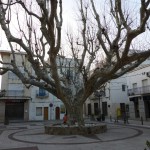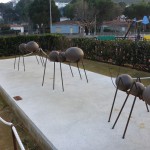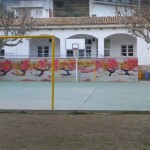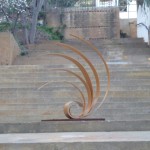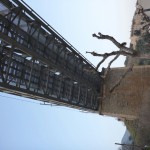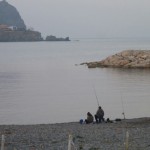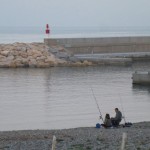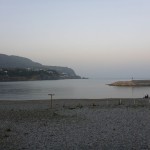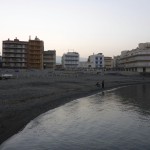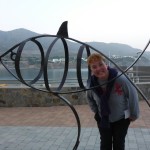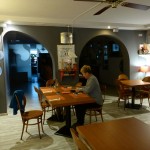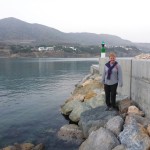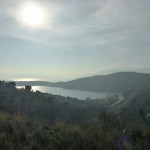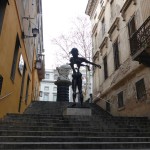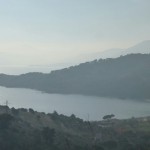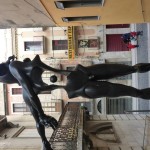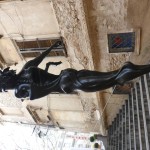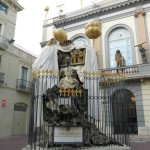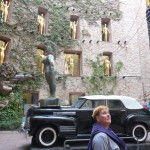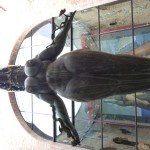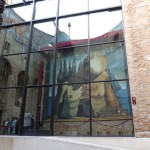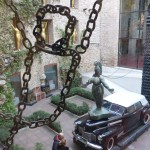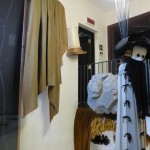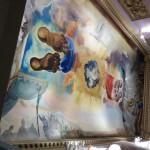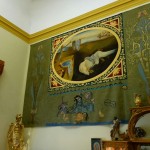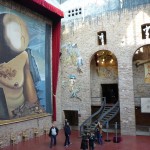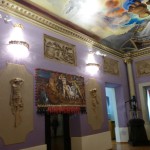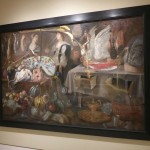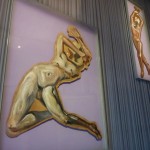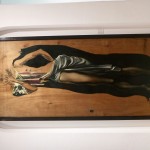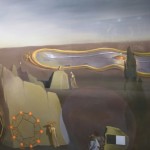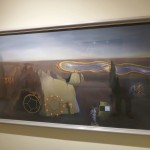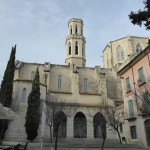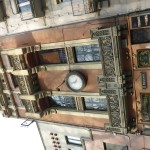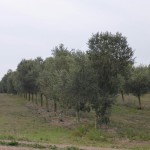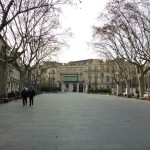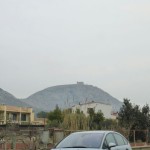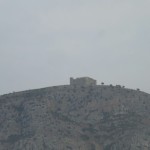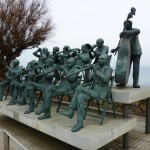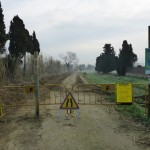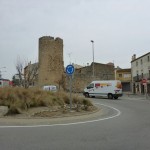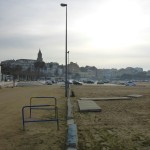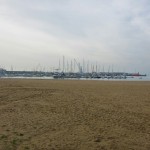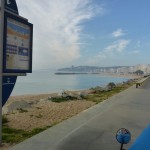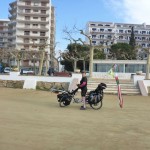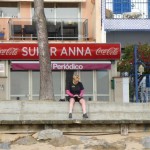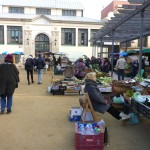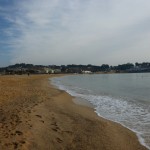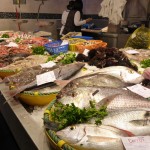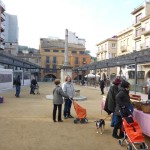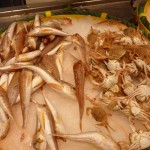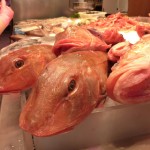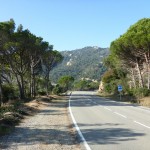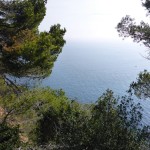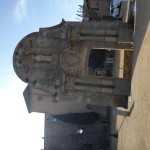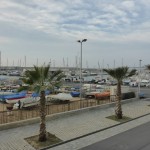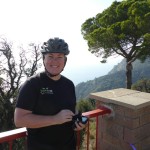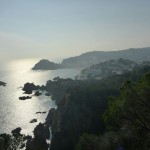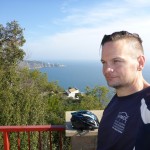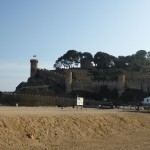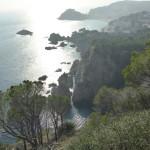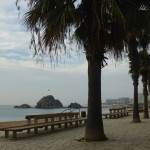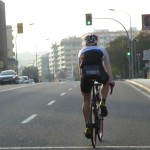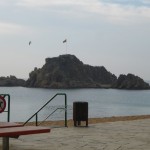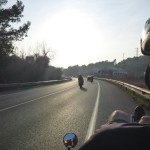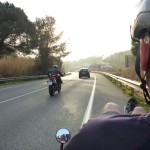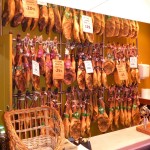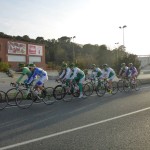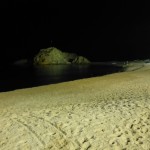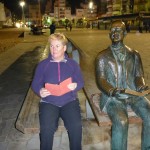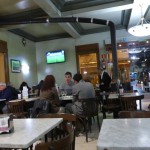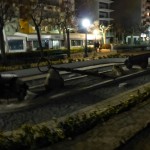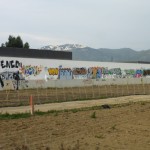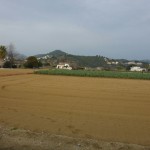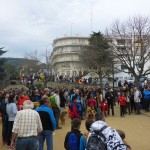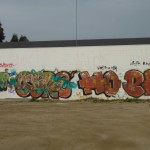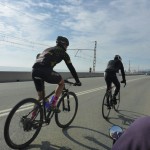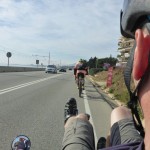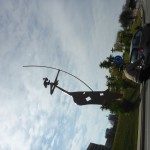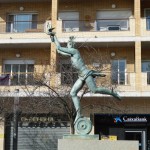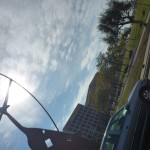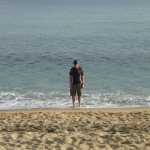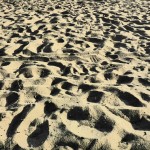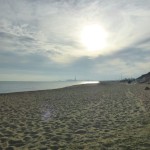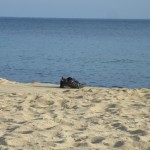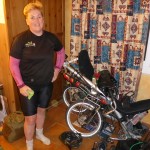Sunday 14 February – Gandia to La Nucia
Distance 83.04 km
Max speed 55.4 kmph
Average speed 16.6 kmph
Total 2218.75 km
Last night we went into Gandia and discovered there was a street fayre with all sorts of stalls, dancing with castanets, and streets thronged with people.
It was completely unexpected and all the more entertaining because of that. We stopped to have a mojito at a stall Daz was convinced was just a guy and the remains of his drinks cabinet from home, then we headed to the square to watch the people traffic.
We finally return to our hotel to enjoy my Valentine’s present. Yummy!
This morning having had breakfast and stolen enough for snacks and lunch from the buffet we head off.
We find the Via verte and it’s good riding with a strong wind that’s just on the back of our right shoulder. Good speed and excellent progress. We see a huge fruit and vegetable market in the industrial estate outside Le Verger but we push on because we want to visit Calp. En route we’re passed by 3 road bikers and we decide to give chase. I only wanted to draught them but when we catch them up they’re going so slowly we have to overtake.
A massive boost to my ego passing unladen road cyclists but are soon left eating their dust when there’s a climb that goes up and up for almost 6km. After a really fast, winding descent into Calp we head to a camping ground because we met a couple, Peter and Heather Dedman when we were in Castelnau in France in December and they said if we made it to southern Spain to pop in.
When we find the correct site we’re disappointed to find they’re out. But instead we start chatting to a couple of English people and then they stroll in. We have a lovely cup of tea with them and chat about their caravaning experience. They’ve been on the site in Calp since before Christmas and there’s a big community spirit there.
Peter is a big football fan so he and Daz spend most of the visit glued to Leicester V Arsenal.
After the visit we cycle to the beach and have our lunch.
We’re just starting the climb out of Calp when there’s a sudden, heavy rainstorm but we quickly find shelter and manage to stay dry.
We’re soon back on the road heading up out of Calp to Antea and finally on to our warmshower hosts in La Nucia. Alberto and Ana are our hosts. It’s great chatting to them because they spent a year cycling the length of south America; so we get some great information from them. But even better they’ve just bought themselves a traditional tandem and spent 3 weeks cycling in Indonesia, Malaysia and Singapore. It‘s fascinating listening to how and why they’ve transitioned. We share stories over a lovely dinner and Alberto gives us some route suggestions.
Monday 15 February – La Nucia to Santa Pola
Distance 76.45 km
Max speed 58.4 kmph
Average speed 16.2 kmph
Total 2295.2 km
An entertaining night, we woke at about 4am to discover that the poorly inflated mattress ( Daz thinks they function better if not too well inflated) had lost more air and we were mostly lying in a central trough, in contact with the floor. Various parts of my body had gone completely numb. We then set about trying to reinflate it without the pump making so much noise it woke everyone else. Daz tried smothering it with his body and blankets. I don’t think he was successful but it was funny to watch. After breakfast, having bid a fond farewell to Ana and Alberto, we set off.
First we head into Benidorm and cycle along the esplanade: it was beautiful, sea and a beautiful expanse of sand and then hills in the background. What a fabulous way to start a……… Monday morning – yup identifying the day of the week is really tough these days, we lose track so quickly.


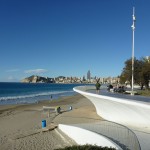

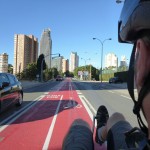

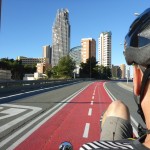 Cycle path in Benidorm is in the middle of the road!
Cycle path in Benidorm is in the middle of the road!
Then after Benidorm we head to Villajoyosa. The area is famous for its chocolate industry so as recommended by Alberto we stop for hot chocolate.
Unfortunately we don’t think we stopped at the right place but we had hot chocolate. It was delicious but had the consistency of hot custard. From here we headed inland but unfortunately were plagued with pannier problems; one of the catches keeps coming undone and then the pannier hangs off the rack held by only one clip. We stopped half a dozen times trying to sort it!!! Finally we found a solution and reasonable forward progress was resumed and we soon headed back to the coast, and stopped at El Campello for a picnic lunch on the sea front.
Then Alicante where we admired the castle of Santa Bárbara on the hill overlooking the Marina
The Santa Bárbara castle is situated on Mount Benacantil, overlooking the city. The tower (La Torreta) at the top, is the oldest part of the castle, while part of the lowest zone and the walls were constructed later in the 18th century. Then we cycled along the promenade for miles. The promenade Explanada de España, lined by palm trees, is paved with 6.5 million marble floor tiles creating a wavy form and is one of the most lovely promenades in Spain. The Promenade extends from the Port of Alicante to the Gran Vía and ends at the famous statue of Mark Hersch. For the people of Alicante, the promenade is the meeting place for the traditional Spanish paseo, or stroll along the waterfront in the evenings, and a venue for outdoor musical concerts. At the end of the promenade is a monument by the artist Bañuls of the 19th century.
Just a few kilometers from Alicante on the Mediterranean Sea lies Tabarca island. What was once a haven for Barbary pirates is now a beautiful tourist attraction. We can see it as we cycle around the peninsula to Santa Pola.
Santa Pola has an important salt evaporation pond known as the salines which remains in business, additionally, most of it is recognized as the Natural Park of Salines de Santa Pola, an important RAMSAR site. The town was settled over the ruins of a Roman village called Portus Ilicitanus (literally, Harbour of Elche); after being abandoned for decades, then a castle was constructed in the 16th century which marked the repopulation of Santa Pola.
Tuesday 16 February – Santa Pola to Cuevas de marin
Distance 72.3 km
Max speed 47.8 kmph
Average speed 15.5 kmph
Total 2367.52 km
Yesterday was a tough day. Some days we cycle really well together and other days are verging on disastrous. Yesterday was the latter so today we need to be in a better place. So after a good night’s sleep we have a leisurely breakfast then head out of Santa Pola.
We cycle along the esplanade and then cross a narrow dyke with the road on it running between the Salines; shallow salt lakes on either side. We see mountains of salt.
About half way across we notice an old stone tower and then what I had been waiting for… pink flamingoes!!! We pull over in a layby and abandon the bike, crawl under a fence and get as close as we can.
They are beautiful, and when they take off from the water so graceful and pink!!! But soon the bike calls us back, it’s siren call… oops no, wrong book, that’s the one about mermaids!!
We cycle on and before we really know it we are in Torrevieja. We’d discussed lunch options, and MaccyD’s was on the agenda, there’s only so much tapas one can eat!! However, as we are cycling along the front we pass one of the numerous cafe bars and see two people just about to tuck into a full English breakfast!!!! Brake brake brake!! Our minds changed for us by the sight of the wholesome meal to be had we were soon ensconced and tucking in, small one for me and a large for Daz. They soon disappeared and I am sure I could have eaten another!! But after a little while more soaking up the sun we are off again. We are following one of the main roads, but keeping to a very nice and wide cycle path beside it. Unfortunately as nice as it is, when it comes to junctions and roundabouts it’s sometimes too finicky and tedious with kerbs and tight turns on the tandem, so we often find ourselves back on the main road.
On roundabouts we always stick in the outside lane, and as we go around anticlockwise (mainland Europe now don’t you know!) I indicate left if we are passing an exit. Today a couple of old biddies obviously cannot work out what is happening as we are halfway past an exit when they cut in front of us to try and take thus said exit!!! Loud swear words prevail, and we can see they are all a fluster with the swerving that carries on having exited… really, old people need to give their licences up!! Talking of which, no sooner has this happened than we are cycling along a road adjacent to the main one and find our way blocked by a car that has just scraped up the side of a van and is now sat blocking the carriageway.
Another oldie emerges from the driving seat of the offending vehicle… must be about 80, wearing only his boxer shorts, no shoes or anything else. He is either pissed or suffering from dementia, the van driver is going mental and the old man just seems to be nonplussed!! Daz thinks he is English, but I am not sure. The vandriver wants us as witnesses and to call the police but we feint a lack of language and understanding and push past on the bike… I am sure the road will be blocked for some time to come!!
After more time in the hot weather and getting tired we finally arrive at John’s house, an old friend of mine from the army. He’s out playing golf, but has left us keys with the neighbours. We let ourselves into his compound and say hi to his two dogs Jack and Roxy, who, after having barked at us for a while, go off to hide – we can’t understand why they’re so unfriendly but we think it’s the bike!!
Daz does some maintenance on the bike as I get freshened up, and when I come back out I notice the neighbour’s chicken wandering in the garden. As I walk over to it it runs off, but then this sets off the dogs who eagerly give chase and then I am horror struck as the jack russell catches it and starts running around. Memories of the incident with Mike and Sandy runs through my mind, but fortunately as I run up Jack releases the chicken unharmed!!
John arrives back from golf a little later and we discover the chicken is one of his which he keeps in the orchard next door. He says he has lost 2 to the dogs before !! I met John on my first posting to Cyprus (1992 to ‘95) and haven’t seen him since apart from crossing paths with him in Shaiba palace Iraq in 2003. It’s amazing the Army network, everyone eager to help others out. It’s wonderful to contact someone from my distant past and for him to open his door to us. We have a bit of a catch-up and then he takes us into the village for dinner and a few drinks.
I enjoy reminiscing about old colleagues and old times. His son, Dan, has just joined as a specop (my first trade before I rebadged to AGC) and is currently in trade training. I still have nightmares about my trade training, trying to learn morse but apparently they don’t learn morse anymore. John has a beautiful home out here in Spain but sadly the tug of family and a new baby granddaughter has drawn Maria back to the UK. As usual Daz and I play the ‘fancy a house here’ game. It’s beautiful and the area is surrounded by all sorts of salad and vegetable crops. John can just walk around and pick his own for his dinner. Unfortunately he’s not a fan of artichokes, all mouth and no trousers, and there’s acres of those here.
Wednesday 17 February – Cuevas de marin to Cartagena
Distance 37. 44 km
Max speed 42.2 kmph
Average speed 15.8 kmph
Total 2404.96 km
We get up in time to see the sun just above the horizon whilst sipping a lovely cup of tea from John’s terrace. The skies are clear and blue and it’s looking to be a good day. We take the dogs for a walk around the fields that are full of artichoke or citrus trees which surround his house. Then after some breakfast we say farewell to John. Thanks so much once again for putting us up.
The route today to Cartagena is less than 40km so we take it steady and marvel at all the crops growing in the fields and see the shepherds out with their sheep.
We see workers hand picking celery and artichoke then stop to watch a machine manned by 4 people as it moves along a row of baby spinach. Cutting blades at the front ‘mowing’ the spinach up onto a belt that then drops it into boxes. They even offer us some to take with us!!
We reach Torre Pacheco which is about half way and stop beside an old flour mill to have coffee and tapas. There are 14 of these old windmills in the area, with 4 having been restored. The one we can see looks beautiful.
As we cycle on towards Cartagena the wind picks up and the road gets busier, making it a more difficult ride than anticipated. But soon we are within the city limits and racing down towards the harbour area, at one point I thought we were getting our second wind as we seemed to hurtle down the road, Daz blasé about the traffic to the left and right of us!
Cartagena is steeped in history. It has been inhabited for over two millennia, being founded around 227 BC by the Carthaginian Hasdrubal the Fair as Qart Hadasht, the same name as the original city of Carthage. The city had its heyday during the Roman Empire, when it was known as Carthago Nova (the New Carthage) and Carthago Spartaria, capital of the province of Carthaginensis. It was one of the important cities during the Umayyad invasion of Hispania, under its Arabic name of Qartayannat al-Halfa. There are still many Roman archaeological examples in the city including an amphitheatre.
Much of the historical weight of Cartagena in the past goes to its coveted defensive port, one of the most important in the western Mediterranean. Cartagena has been the capital of the Spanish Navy’s Maritime Department of the Mediterranean since the arrival of the Spanish Bourbons in the 18th century. As far back as the 16th century it was one of the most important naval ports in Spain, together with Ferrol in the North. It is still an important naval seaport, the main military haven of Spain, and is home to a large naval shipyard.
Thursday 18 February – Cartagena rest day
We do some geocaching but it’s not a huge success. We spend an hour looking for one cache and even a policeman stops to find out what we’re up to. We still didn’t find the cache!
But we do manage to finish Game of Thrones – but John Snow is dead – Gutted. Carl Broadhurst informed us that this was common knowledge and only 2 people opting out of the ratrace would miss this news. Great series though!
Friday 19 February – Cartagena to Palomares Bajo
Distance 110.42. km
Max speed 71.8 kmph
Average speed 17.1 kmph
Total 2515.38 km
Wow… our longest days ride so far and also our fastest maximum speed. And considering it was hilly a good average too. It’s been a cloudy day and we did think we’d hit rain showers but fortunately there was no rain.
Our first hour was spent climbing until we hit the highest pass in the Parque Regionale Sierra de la Muela. Then a long and fast (fastest to date remember!) descent into Isla Plana. From there we cycled to the outskirts of Marrazon and stopped to buy lunch provisions. Then we decided to leave the main road in favour of a more direct route to Aguilas. The unfortunate point about this route choice was it was uphill. Fortunately we’d had lunch (sat on the side of the road in a drainage ditch!) so we were refreshed but it was still a long climb.
Finally we reached the top and had over 2kms of descent but the bends were so tight that we didn’t dare go too fast. We stopped in Aguilas for a break with nearly 80km under our belt. Having had a rest day in Cartagena yesterday our accommodation/workaway plan was to get to Almeria in 2 days… the only problem is that it’s definitely over 200 km, which means we need to push on today beyond our normal 70 or 80 km. So we carry on… we have a few campsites bookmarked on the map but not knowing if they are open could be a problem. However the first one we try at 110km is open… it’s also partially nudist!! Decisions, decisions!! Finally we opt for the clothed side of the campsite and get our tent set up. It’s a fair decision, as the sun hasn’t been out all day and going nudist would be a tad chilly!! I think Daz would like to be just on the edge of the nudist area but unfortunately for him we need shelter from the wind and the shelter is all on the other side of the campsite – poor Daz, think he fancied a bit of voyeurism.
If you read last weeks blog you will know we got rid of lots of kit to reduce weight… maybe we were too drastic in cutting down to one towel, as it’s now always a fight to see who can get to the showers first to use the dry towel… he who is tardy, must moist towel use!! Today Daz is Mr Moist Towel!!
Saturday 20 February – Palomares Bajo to Almeria
Distance 102.53 km
Max speed 60.8 kmph
Average speed 17.9 kmph
Total 2617.91 km
It rained in the night, thankfully not a lot, but it woke me and then I didn’t sleep well for a while. I was worrying about the bike seats getting wet and then in the morning Daz told me he’d already brought them in. In the morning the clouds were dark, and an old man told Daz to expect rain. Daz told him winter is coming!! We packed the tent and got on the bike, all of 100 meters to our breakfast stop! Then it was on towards Almeria, another 100 km day if we were to get there on schedule. In front of us the mountains were covered in black clouds and we could see rain, but as we cycled towards them we could see them being pushed inland and the weather following it seemed clearer. With the tail wind we were making good progress with only a little discomfort from yesterday’s tired legs.
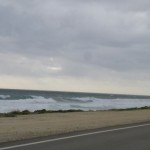
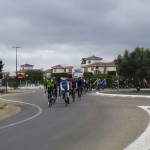
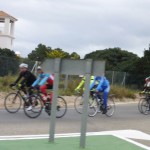
We turned off the main road at Garrucha to stay on the coast. And as we dropped down beside the sea we could see the waves rolling deep and dark against the shore, the wind whipping up white horses all along the coast.
As we neared Mocajar we knew we had some climbs, and as we turned from the coast up into the hills it didn’t seem too bad, just put it in low gear and grind up, with some assistance from the wind at our backs. However, after about an hour of climbing we reached the summit, and suddenly the wind was really howling. So much so that we had to take the flag down.
I hated the way the wind was buffeting us across the road when it came from the side, and I was already dreading the descent (we struggled to hold the bike still just taking the flag off) and the road, instead of doing switchbacks down the side of the hill actually looped around a single hill so the wind came from all directions. I had asked Daz to take it as slow as possible, but he was complaining that at too slow a speed the wind affected us more, so we needed to keep some speed to punch through. As we neared the bottom, I’d thought the worst was over, but then we crossed an exposed bridge and we were really hit by side winds. I’d had enough and started bawling like a baby (the only tactic I could think of to make Daz stop – of course he was enjoying it – pitting himself against the weather Gods!!). We stopped for a while and once I’d recovered my nerve we pushed on. Fortunately we then turned along the coast again and the wind was at our backs for a while.
We stopped in Carboneras for a coffee and respite from the wind, but knew we had to push on. At this stage I was feeling really tired and sick and would gladly have given up cycling forever!!! But we’d actually only been riding for 2 and a half hours and done 34 of a 100km day. So off we went. Another climb and descent into Agua Amarga and we were both feeling pooped. But still another climb up onto a vast plateau and the wind still pushing us all over the road unless the road kept it directly on our backs. We cycled into Los Cortijillos hoping to find a lunch stop but we blinked and the village was gone. The next village, Fernán Pérez, looked even less significant on the map but also appeared to be the last village for miles. It didn’t look promising but then we cycled the narrow streets and turned into a courtyard and found the only taverna in the village. But what a find, it was full of people eating Saturday lunch, and we must have looked a mess as we parked the bike and walked in. A Spanish lady came and took our order, there was no menu, but we ordered a primero of paella.
Immediately two steaming plates of mixta paella arrived with a salad and bowl of bread, amazing! We were famished and tucked in with relish. The lady came back and asked us if we wanted ‘secundo’? But we were full from the first course so went straight to ‘postre’ or dessert. Not understanding what we were being offered I selected the one that had the word chocolate in it, and Daz pointed at someone else’s dessert and said he would have that!! Mine turned out to be a small tub of chocolate moose, whereas Daz’s was a huge plate of creme caramel, little squares of vienetta and loads of whipped cream. Yummy. At this stage we were questioning whether we’d make Almeria and whilst Daz thought there was a campsite in the vicinity (he’d seen signs), I firmly stated our cutoff was 6pm. At this point it was 3. 45pm and we’d been told Almeria was still 50km away. Seriously demoralising because we thought we were already over half way. So off we went feeling totally dispirited.
We cycled out of that little village at least replenished in energy, what a fantastic little find- fabulous lunch. Having looked at the map we knew we had at least another 50km to do. Thankfully as we left the village and crested a small hill before us we could see vast open countryside, flat as far as the eye could see!!
Soon we were coasting along a quiet road looking down on huge plastic covered greenhouses, each as big as a football pitch and covering whole square kilometres of the terrain. As we turned left in one village the wind again was directly behind us and we really picked up speed on the flat smooth road and barely needed to pedal for one km after another. It looked like we would reach Almeria after all. But the day was to have one more sting in its tail. We decided earlier to cycle towards an autovia, that would lead us to the N344 into Almeria, but as we cycled towards the entry ramp we saw a sign saying no cycles… damn! I wanted to go for it, it was only 3.3 km to our junction and I didn’t want to have to cycle back to the original road we had planned to use against the wind. But Daz reckoned we could take a service road that ran beside it, so off we went, but after about a km it stopped being tarmac and turned into a rocky, dusty track. But there was no going back against the wind, and angrily I pushed the bike along the unrideable terrain, thinking at least it was only 2km.
At times the track ran down into dry river beds and we had to struggle to push the bike up the other side. I was tired and irritated and it was showing, so when we got within sight of the autovia junction and saw a massive big hill to push up I was totally crushed. We were about 100 meters away but it was too steep and loose surfaced to be able to push the ‘pig’ up it and actually this ‘service road’ didn’t actually join the autovia slip road. We had no choice we needed to get onto the autovia. We took the bags off the bike and lobbed them over the wire fence seperating us from the autovia. I then climbed it and Daz picked up the bike and passed it over, a right pain in the arse, literally, as I tore a hole in my shorts and got chain oil all over me. Then we climbed a bank and moved everything over the barrier onto the hard shoulder of the autovia. As trucks whizzed by we raced to get the bags on the bike and get to the safety of the exit lane we wanted 100 meters away!! Scary! Later we checked vehicle restrictions on autovias because we have used them before. Helpfully on some bicycles are permitted and on others they’re not.
Fortunately we were OK, and didn’t get arrested and soon we were moving again down a very quiet road towards Almeria. The map said we only had 15 km to do and the sun was shining. After a long hard day I was thankful for the quiet.
We navigated into the centre and found a bar, a well earned cerveza, and some WiFi to find accommodation! As luck would have it, we found a budget hotel only 100 meters from the bar, fab!!
After a rest and clean up we popped into Almeria in the dark and wandered its quiet streets. We popped into the Cathedral where a service was going on and walked beneath the walls of the ancient Arabian fortress Alcazabra. Finally we wandered back to the hotel, but popped into a very small tapas bar over the road. Wow, what a find, the place was only about 15 feet by 15 feet but it was packed full of people enjoying a drink and tapas. We elbowed in and joined the fun, communicating by many various methods our drink order and tapas order. All of which were wonderful and delicious – Daz wrote this and fibbed. His last tapas order was achieved by pointing at the seafood counter. Along came squid and cuttlefish. The squid had been griddled and was good but the cuttlefish – Daz only managed one ( oh yeah he thinks they were baby cuttlefish), his hands and tongue were black with the ink and he hated the taste and prying out the budgie bone. I thought they were OK. But the vibrancy of the bar was incredible and Almeria is famous for its tapas. A fab end to a very, very rough day.
Sunday 21 February – Almeria to Granada
Today we’re going to take the train to Granada so after a leisurely breakfast we finally cycle around town and then head to the beach. It’s really busy but the sand is a dirty brown and we’ve definitely seen better. The wind has dropped since yesterday but there’s a fog coming from the hills.
After enjoying the town we stop so Daz can have churros and hot chocolate.
Eventually we head off to the train station, buy our tickets and start to wonder how we’ll manage with the bike. Fortunately our train is already in the station and we soon load the bike and gear.
But there’s a problem and we need to move everything to the other side of the carriage – we hadn’t noticed because there’s a set of stairs but this is where all the bike racks are situated. Everything is nicely stowed, the train conductor is happy with us and we’re off. 2 and half hours to Granada with just one stop at Guadix. We watch the scenery which passes by. At first we are climbing through scrub and arroyo, rocky outcrops and ravines with dry riverbeds.
But then we reach a plateau and for mile after mile it is a flat, dry scrub with hardly any vegetation . What we can see are cultivated plantations, but even these are scrabbly little trees that have no foliage. We pass a wind farm, its huge, row upon row of slowly turning turbine blades, each row stretching off into the distance. We were expecting to see huge solar farms, but we only see one little one by a village. We occasionally see a small village snuggled up to a hillside, the houses all painted white to keep the fierce summer sun at bay. Finally we pull into Granada and debus. Reload the bike and wander into town.
Granada is a city and the capital of the province of Granada, in the autonomous community of Andalusia, Spain. Granada is located at the foot of the Sierra Nevada mountains, at the confluence of four rivers, the Beiro, the Darro, the Genil and the Monachil. It sits at an average elevation of 738 metres above sea level, yet is only one hour by car from the Mediterranean coast, the Costa Tropical. Nearby is the Sierra Nevada Ski Station, where the FIS Alpine World Ski Championships 1996 were held.
The Alhambra, a Moorish citadel and palace, sits on a hill overlooking Granada. It is the most renowned building of the Andalusian Islamic historical legacy with its many cultural attractions that make Granada a popular destination among the touristic cities of Spain. The Almohad influence on architecture is also preserved in the Granada neighborhood called the Albaicín with its fine examples of Moorish and Morisco construction. Granada is also well-known within Spain for the University of Granada which has about 80,000 students spread over five different campuses in the city. The pomegranate (in Spanish, granada) is the heraldic device of Granada. There is also a humongous cathedral.
In the evening we walk along the beautifully lit Gran Vía and around the Cathedral area. It’s full of bars, cafes and tourist related shops, little alleyways filled with souvenir shops flow away from us left and right. We try getting in the Cathedral for a looksee but it’s just shutting, so we go to a tapas bar instead!
We think the plan tomorrow is some sightseeing then cycling on to our workaway job up in the hills!
Monday 22 February – Granada to Venta Valero
Distance 66.57 km
Max speed 55.6 kmph
Average speed 13.4 kmph
Total 2684.48 km
The Alhambra is the main tourist attraction here but we need several hours to do it justice and since I don’t manage to drag my sorry arse out of bed until after 10am, we’re not going to have time. Instead we head back to the Cathedral but Daz refuses to pay the entrance fee. Then we cycle to the Monastery and I refuse to pay the entrance fee. Funny if it was a glass of red wine we’d both pay instantly. Then we head to the bullring.
San Jeronimo Monastery is the first monastery to be built after the conquest of the city by the Christians. Here was buried the Great Captain. The construction of the monastery of San Jeronimo began in 1496, at a place called the Almoravid, now occupied by the hospital of San Juan de Dios. All the stones used for its construction were taken by the Kings from the Arab gate of Elvira.
The first courtyard of the Monastery of San Jeronimo has thirty-six semicircular arches with shields with the initials of kings, the first Archbishop of Granada and the monk Jeronimo Hernando de Talavera. The second has short arches in the Gothic style.
The main attraction of the Monastery of San Jeronimo is the sacristy, one of the best examples of Spanish Baroque. The viewer is dazzled by the sight of the effect the light has on the ornamentation created by Luis Cabello, who produced more than a thousand carvings. The Monastery of San Jeronimo also has one of the best works of Gil de Siloe, his beautiful altar.
The impressive bullring, Plaza de Toros de Granada, an international center for bullfighting is one of the most notable landmarks of Granada. With its characteristic arches and Arabic style, this iconic, Neo-Moorish structure fits perfectly in one of the most charming areas of the city. The bullring has been declared a Monument of Cultural Interest in Spain and is a significant part of Granada’s architectural heart.
After sightseeing we headed off to our workaway host. The cycle ride out of Granada was nothing special, it seemed to be an industrial area with a foggy haze hanging over it. Out of Granada, after 10km of easy riding we hit the hills. One in particular was over 6km but there was no rewarding downhill only a short reprieve before the next climb. After 30km we stopped for lunch in Puerta Lope and then left the main road for what we were hoping would be a lovely ride along a country lane.
Well it was indeed very scenic but the hills continued and now we had a head wind. We soon shifted into granny ring but we were still struggling. We cycled into Montefrio and saw a village with a striking setting, with one of its churches perched on top of a bare, rocky pinnacle, overlooking the town and its surrounding hillsides clothed in olive groves and fields of cereal crops.
It nestles between two memorable hilltop churches; you can’t miss either of them since they dominate the skyline. All we could do was think ‘OMG hope I don’t have to go up there!!!’ – and we didn’t, we skirted round the bottom of its hilly perch and pushed on. Only 12 km we said to ourselves, how hard can it be – well fxxking hard is the answer. It was hill after hill after hill. The gradients were too severe for us and then the road surface changed to glue.
Actually it wasn’t glue it was just rough tarmac but we lose all momentum on this and the final 1500m wasn’t even rutted tarmac, it was gravel. We’d pushed the ‘pig’, uphill for several kilometres and we were shattered. And it was only 67km of cycling – we’d only been recently congratulating ourselves on our speed and distances but not today – gutted.
At the house Des greeted us warmly and showed us to our very cozy ensuite bedroom. His wife, Chris, is currently in the UK but we met their 2 dogs Vinny and Freddy and their 2 cats. They have an old farmhouse with a lovely plot of land with olive and almond trees. From the top of his property there are incredible views of the surrounding countryside. We ate dinner with him and chatted about a diverse range of topics including chi walking / running, buying and living in Spain, workaway and housesitting sites and Spanish lessons.

